Samsung Q8F is quite a successful continuation of the Q67D model. It offers similar picture quality in HDR content, and with a brightness of around 500 nits, it can create an effect that is hard to call average. It is also aided by support for the HDR10+ format, which has been realistically competing with Dolby Vision for some time and provides comparable experiences in many productions. The contrast is also a plus—given its VA panel, it performs solidly and allows for pleasant blacks in movies and series. However, the biggest advantage of the Q8F remains the operating system. Tizen works quickly, provides access to many applications, and integrates well with the SmartThings ecosystem, making it easy to connect the television to a larger network of home devices. Interestingly, the Q8F also has some niche use—thanks to its very good font readability, it works great as a screen for text work. Additionally, the adjustable stand allows the TV to be positioned on practically any desk or narrower TV cabinet. The biggest drawback, in our opinion, is not the image quality itself—because in this price range it's hard to expect miracles—but rather what has happened to the features for gamers. Through updates, options such as VRR and HGiG, which were available even in simpler designs in previous generations, have disappeared. In fact, the manufacturer even boasts about the availability of these features in its catalog. This makes it difficult to recommend the Q8F to anyone planning to hook up a console and expecting full support for new technologies. Thus, the Q8F is a TV that can please—primarily with its design, above-average picture quality, and efficient Tizen system. But at the same time, it shows a step back compared to its predecessor. Let’s hope that Samsung can quickly rectify these shortcomings, as otherwise, even such a successful “everyday” TV may leave some users feeling unsatisfied.
- Matching (Score)
- Our verdict
- TV appearance
- Where to buy
- Contrast and black detail
- HDR effect quality
- Factory color reproduction
- Color reproduction after calibration
- Smoothness of tonal transitions
- Image scaling and smoothness of tonal transitions
- Blur and motion smoothness
- Console compatibility and gaming features
- Input lag
- Compatibility with PC
- Viewing angles
- Daytime performance
- Panel details
- TV features
- Apps
- Playing files from USB
- Sound
Samsung Q8F vs TCL V6C
Direct comparison
Check the best price offer:
Samsung Q8F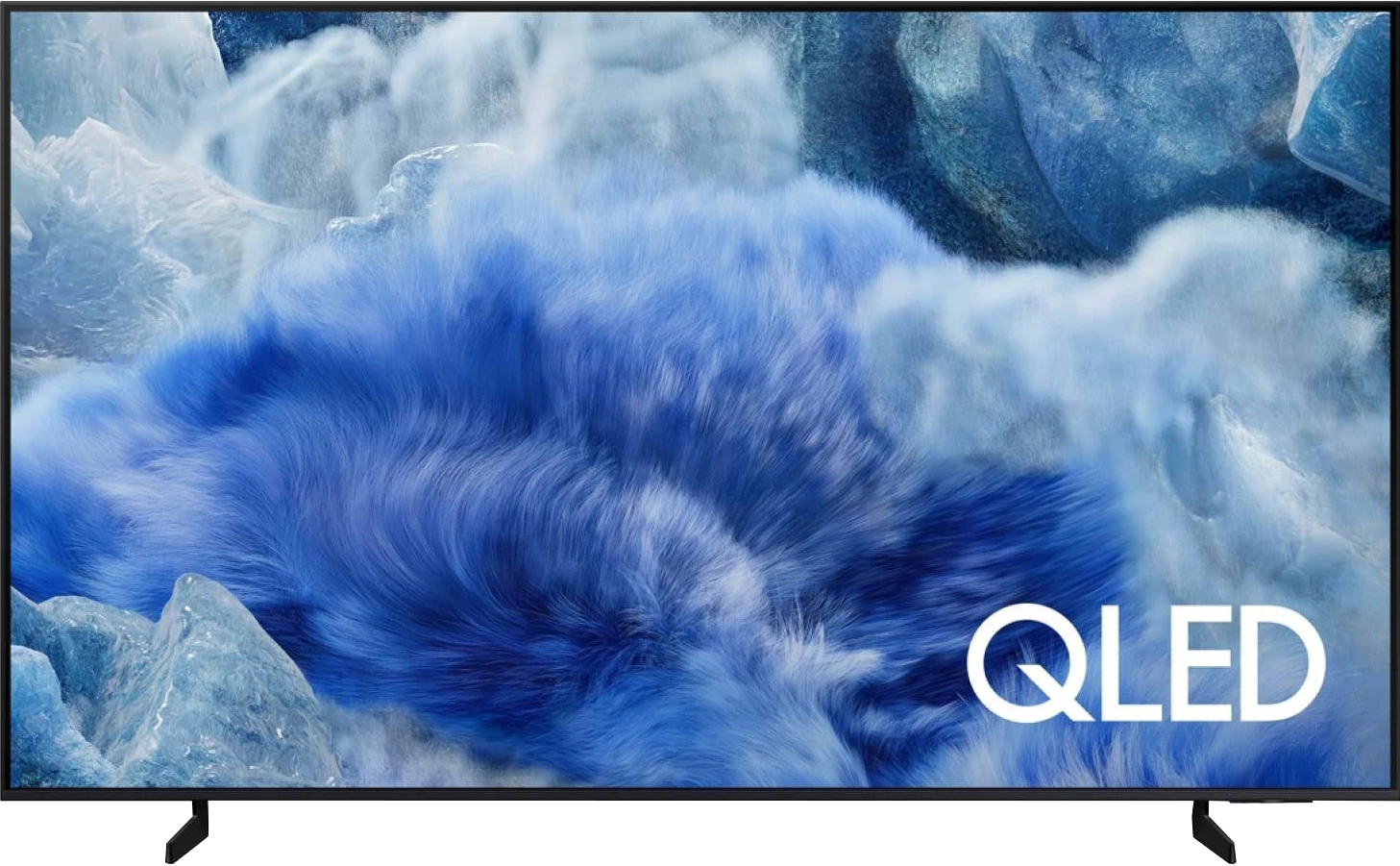
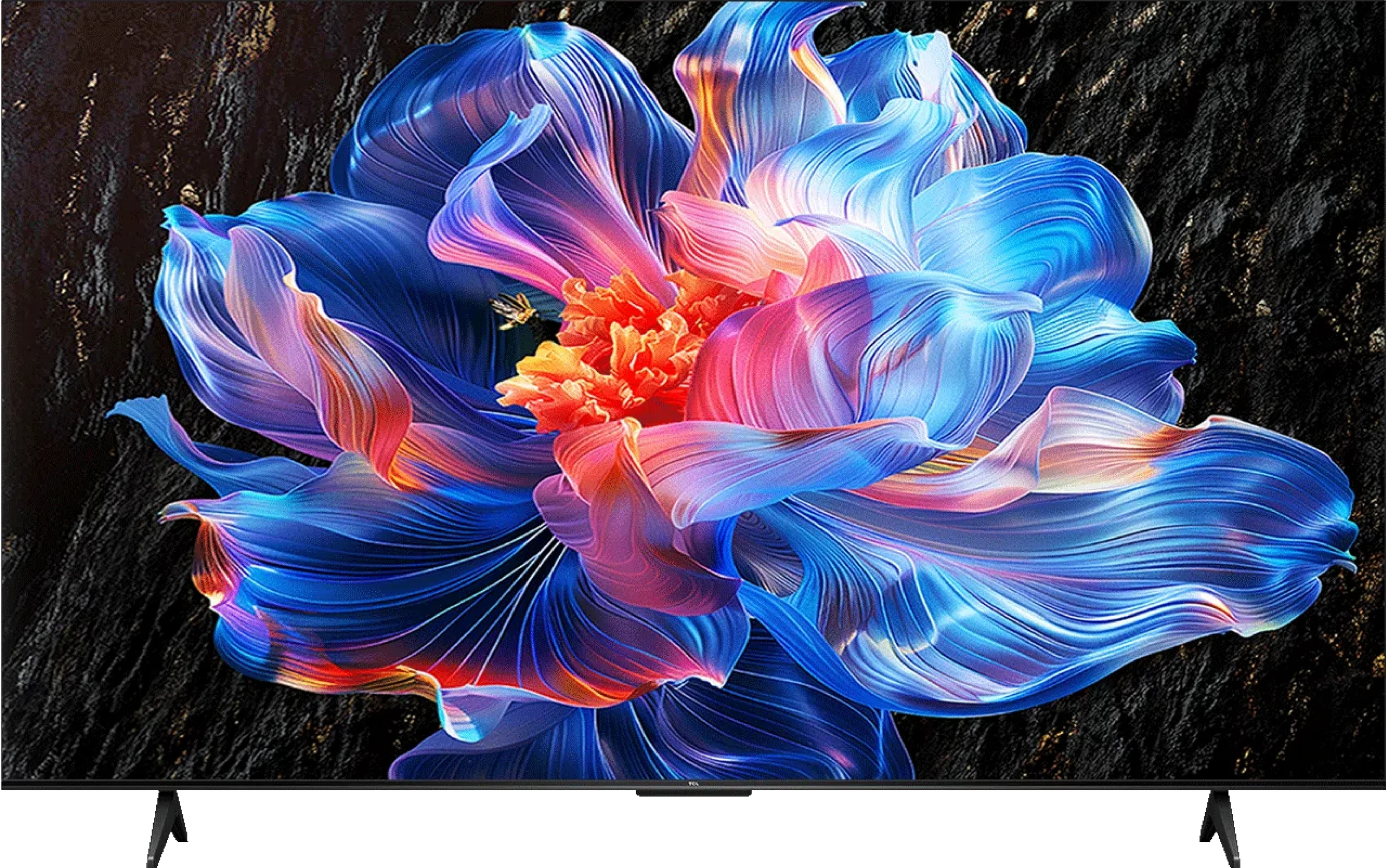
Panel type: LCD VA
Resolution: 3840x2160
System: Tizen
Model year: 2025
Complete the survey to find out the result

Panel type: LCD VA
Resolution: 3840x2160
System: Google TV
Model year: 2025
Complete the survey to find out the result

Overall rating
6.3
5.2
Movies and series in UHD quality
6.3
4.9
Classic TV, YouTube
6.0
5.0
Sports broadcasts (TV and apps)
5.1
3.9
Gaming on console
6.9
6.0
TV as a computer monitor
6.0
4.0
Watching in bright light
5.6
3.6
Utility functions
7.3
7.3
Apps
8.7
9.6
Sound quality
6.0
5.8
Complete the survey to find out what fits your preferences
Advantages
Solid contrast thanks to the VA panel
Pretty good brightness in SDR and HDR (up to about 500 nits)
Satin finish handles reflections well
Tizen operating system – fast, intuitive, with a rich selection of apps
Solar remote with USB-C charging
Integration with the SmartThings ecosystem
Great input lag
Good font readability when working with a PC, suitable as a monitor for text work
Adjustable stand on multiple planes
Attractive price
Extensive GoogleTV system with a large application library
Decent contrast thanks to the VA panel
Quite good functioning dynamic tone mapping feature (often saves the TV for HDR content)
Low input lag below 15 ms
Presence of ALLM mode and a simple Game Bar
Support for Dolby Vision Gaming (Xbox Series S/X)
Support for Dolby Atmos and DTS:X, making it easier to use a soundbar
Disadvantages
Heavily limited features for gamers (no VRR in practice, no HGiG)*,
No recording function on USB or PiP
Average digital image processing
*We hope that the promises made in the advertising brochures will be quickly fulfilled through software updates.
Very low brightness (~200 nits) = no cinematic effects
Narrow color palette coverage, especially in HDR content
Poor implementation of Dolby Vision
Strong ghosting during dynamic scenes (panel only 60 Hz)
Average upscaling – the image can be artificially sharpened
Unusual subpixel arrangement making font readability difficult when working with PC
Limited viewing angles typical of VA panels
The television performs poorly in brightly lit rooms
Google TV system can be sluggish and does not run as smoothly as in more expensive models
Lack of USB recording and PiP mode
Our verdict
The TCL V6C is a television whose value lies primarily in three elements: the Google TV system, several features useful for gamers, and a very low price. It is the Google TV that is its greatest asset – it provides access to a vast library of applications, from the most popular streaming services to lesser-known programs, and also allows the use of AirPlay, screen mirroring, and voice search. For many users, this system alone may be a sufficient reason to consider a purchase. In addition, there are simple yet practical features for gamers, such as ALLM mode, low input lag, and a Game Bar with parameter previews, which make occasional gaming on a console more convenient. The third argument, and perhaps the most important, is the price – in this class, it's hard to find another model with Google TV that offers such broad access to smart features. However, when we move on to image quality, it becomes evident just how many compromises are involved. The V6C is a very dim television. The colors remain poor, and in more demanding scenes, the image can appear flattened and lacking in detail. The contrast provided by the VA panel can be considered decent, but it comes at the expense of weak viewing angles. Additionally, there's motion blur in dynamic sports scenes, as well as an unnatural upscaling effect that, instead of enhancing details, often artificially sharpens them. So who is this model for? The V6C is a television that works well as a simple device for everyday TV watching or YouTube, and its greatest strength is the operating system and low price. However, if we are looking for cheap cinematic experiences or comfortable gaming in modern titles, this model will quickly reveal its limitations. Therefore, when purchasing it, one must clearly understand what they are choosing – it is a television for simple tasks, not a device intended to impress with picture quality.
TV appearance
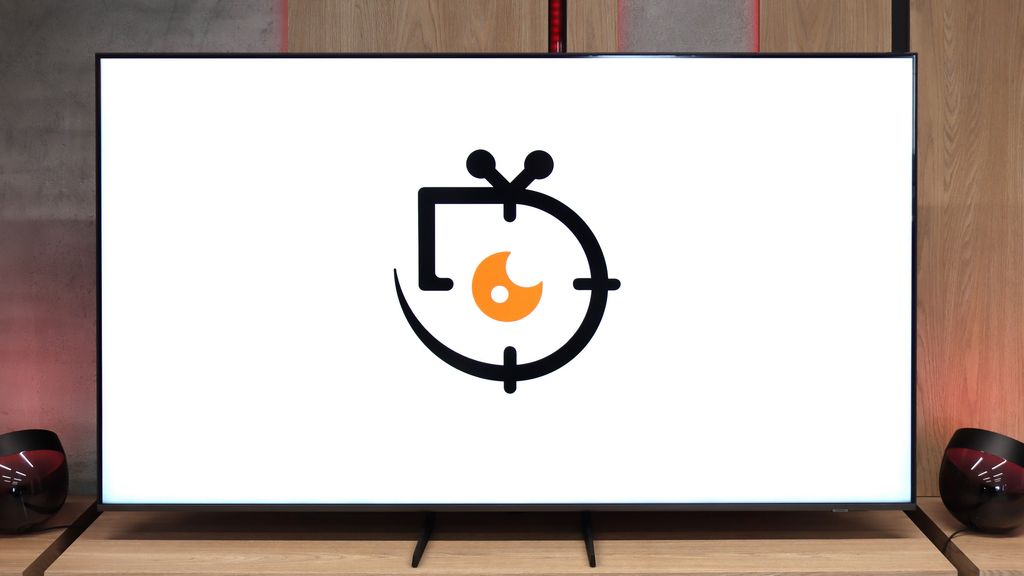
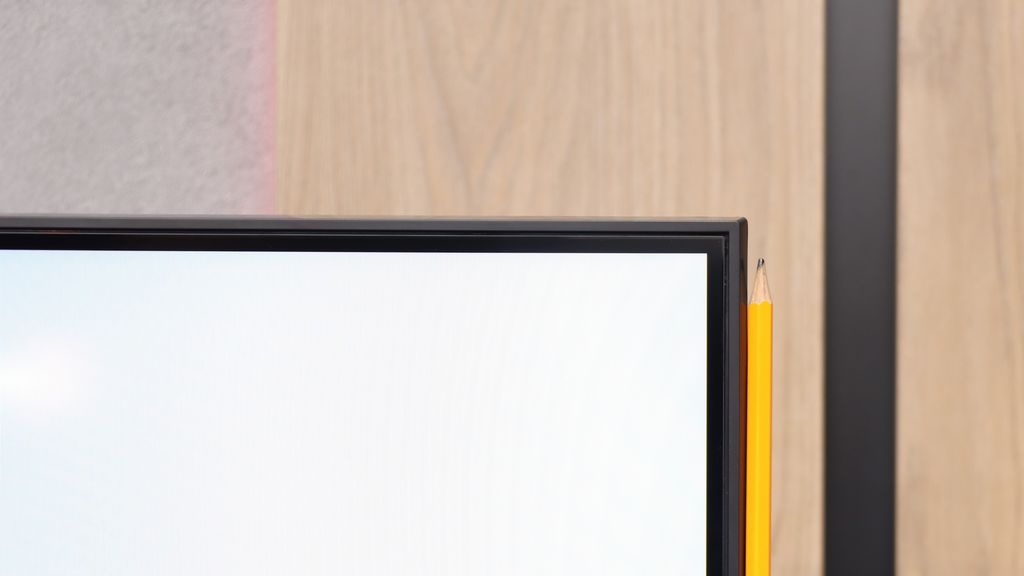
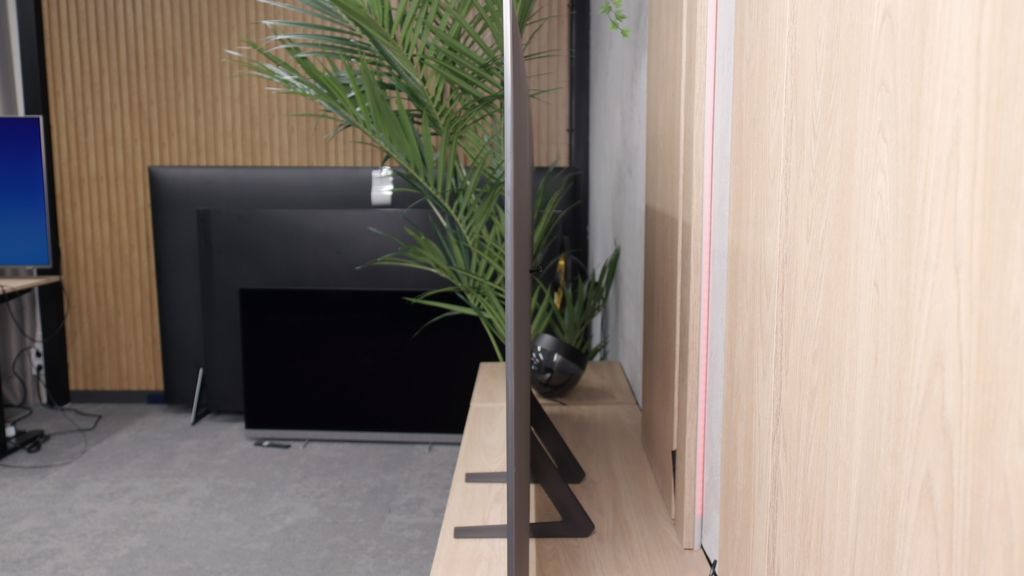
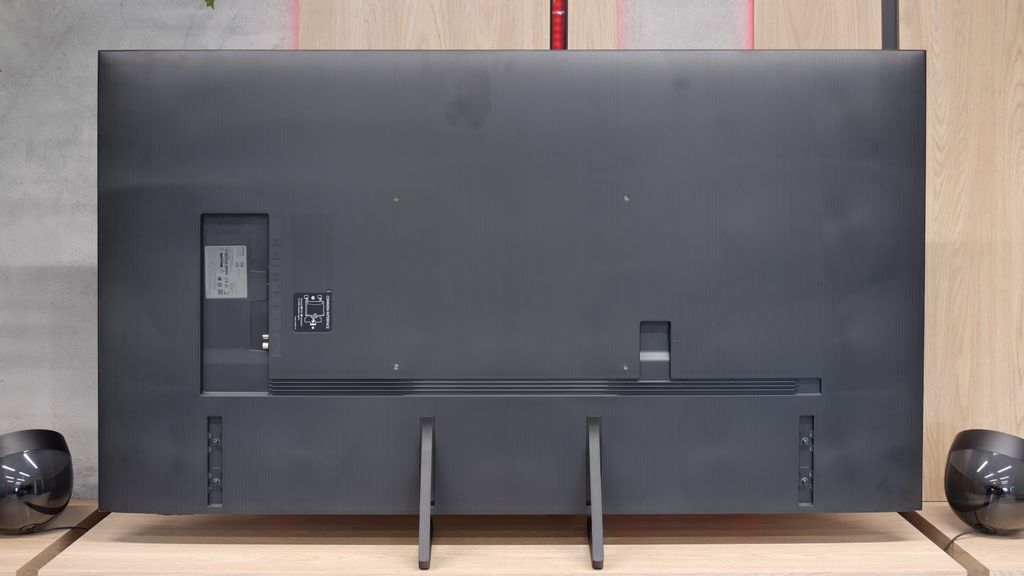
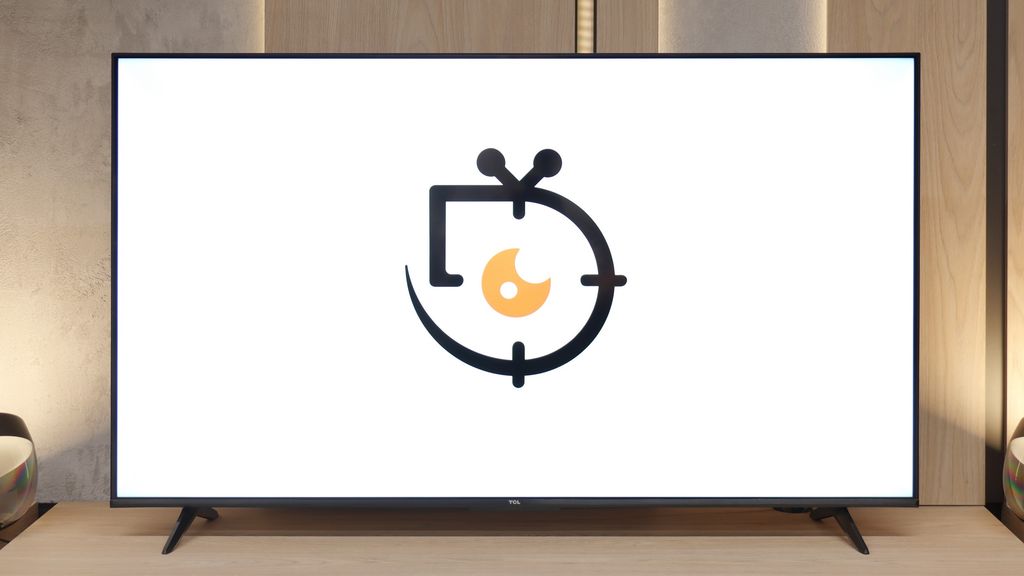
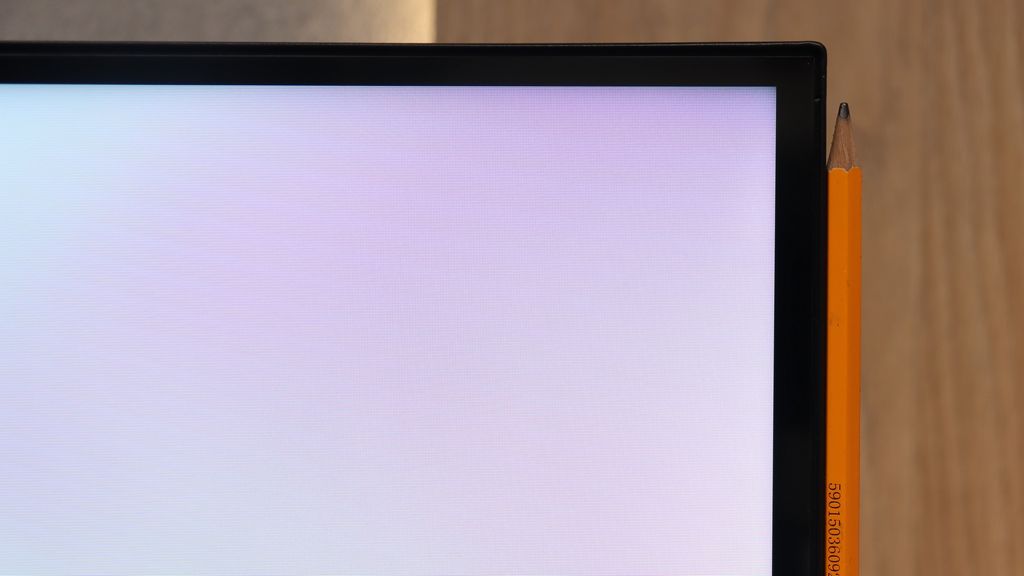
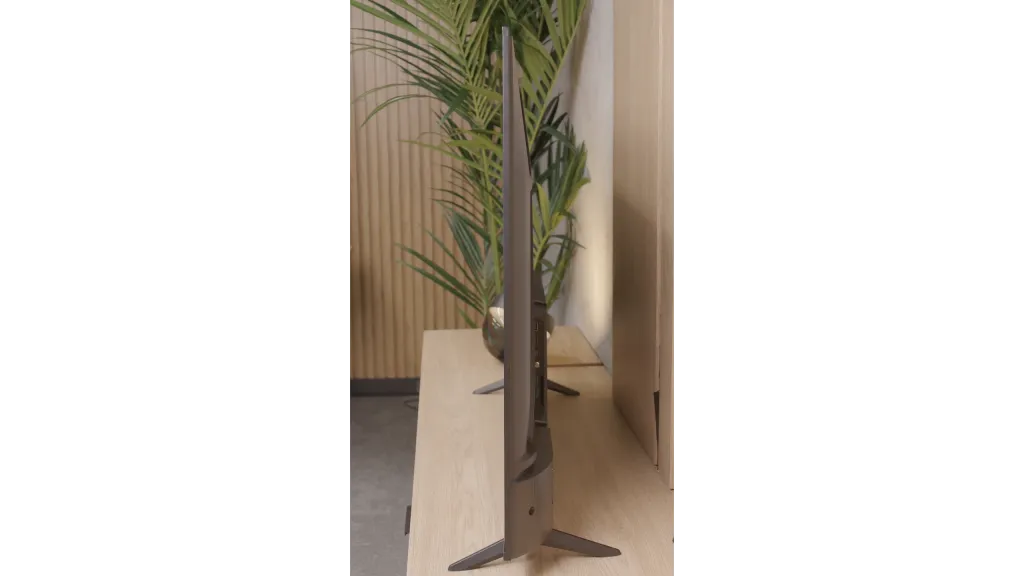
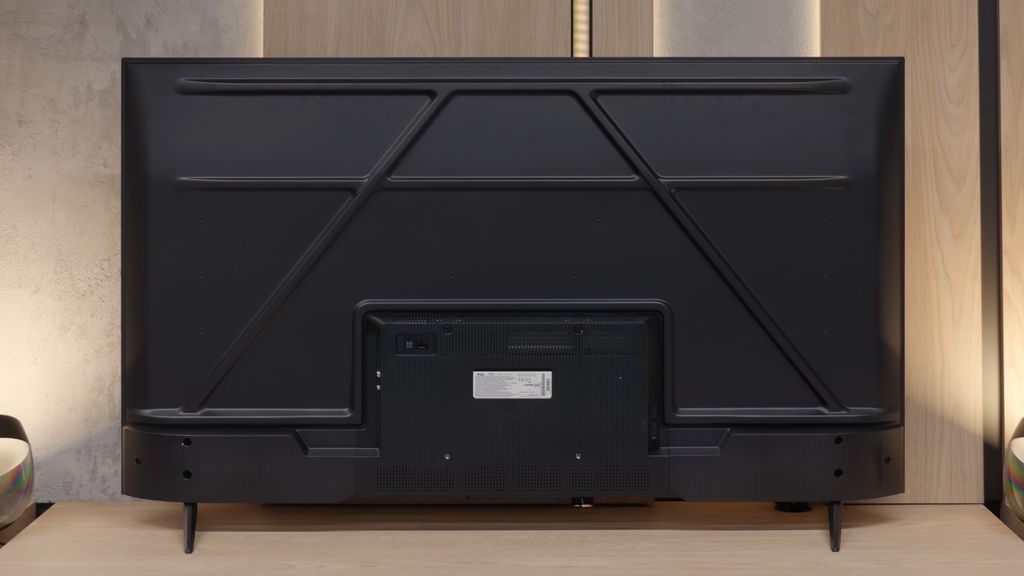
Contrast and black detail
5.5/10
5.2/10
Local dimming function: No
Local dimming function: No
Contrast:

Result
5,200:1

Result
4,650:1

Result
3,650:1

Result
4,100:1

Result
4,150:1

Result
4,450:1

Result
4,900:1

Result
3,150:1

Result
4,250:1

Result
2,550:1
Halo effect and black detail visibility:
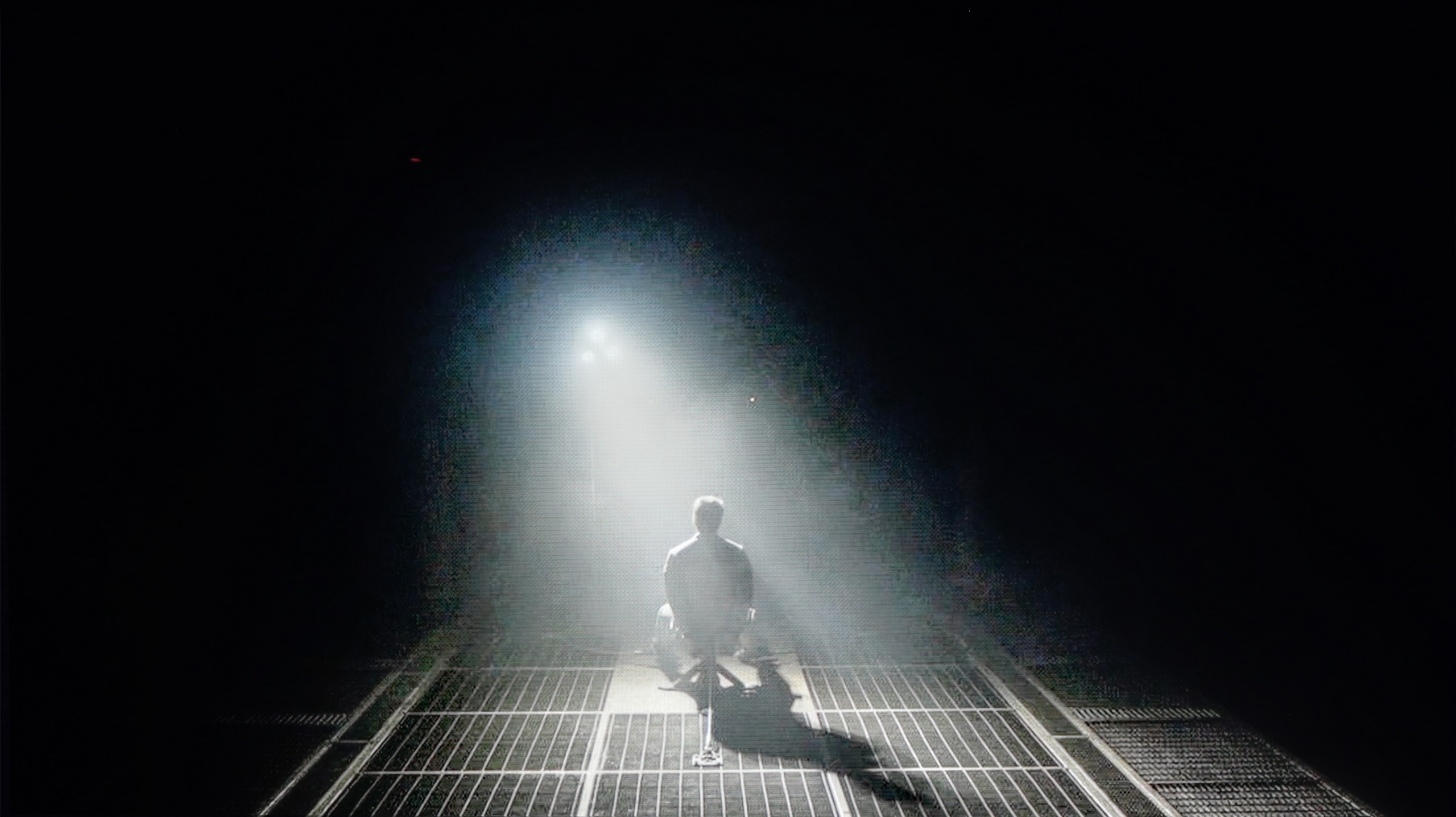
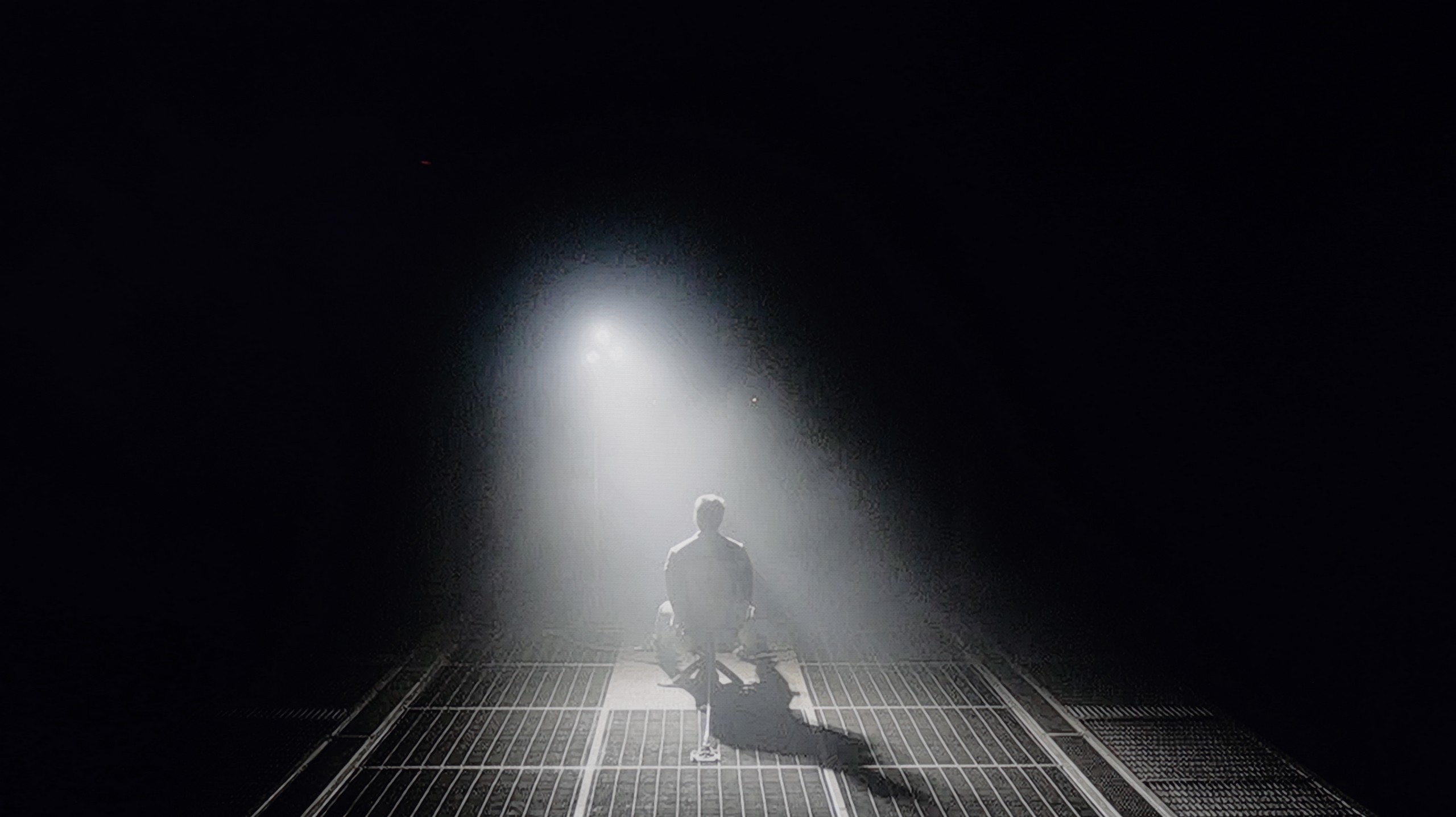
Samsung Q8F uses an LCD VA panel, which immediately puts it in a good position in terms of contrast. By nature, such panels offer deeper blacks than IPS panels, and you can really see this effect here. On test patterns, the contrast maintained a range of about 4000:1 to even 6000:1, which in practice results in a surprisingly engaging picture, especially in a slightly dimmed living room. Of course, this is not the level of LCD screens with local dimming, let alone OLEDs — sometimes the black can shift to a shade of navy blue, and the overall image seems flattened. However, Samsung employs a simple trick: the so-called global dimming, which means dimming the entire screen when a lot of dark areas appear on it. The effect can be impressive but comes at the cost of losing some detail, which may not appeal to everyone. Despite this, the Q8F still presents itself significantly better than televisions with IPS panels, offering solid contrast and blacks that can draw you into the cinematic atmosphere.
TCK V6C utilizes a VA matrix, which is a solution that is considered a reasonable choice in budget televisions. This type of panel offers high contrast and can provide enjoyable experiences, especially during evening movie screenings. Of course, in this price range, it's hard to expect local dimming – this technology simply isn’t present here. The effect is that black won't be as deep and inky as in more expensive models, and at times it may resemble a shade of navy blue. Fortunately, this can be easily circumvented – just turn on a soft light behind the television or place a small lamp in the corner of the room, so that the eye can "trick" itself and the blacks look much better. For equipment in this range, the contrast can therefore be considered decent and sufficient for everyday viewing.
HDR effect quality
5.2/10
3.2/10
Luminance measurements in HDR:

Result
473 nit

Result
417 nit

Result
457 nit

Result
210 nit

Result
471 nit

Result
149 nit

Result
163 nit

Result
193 nit

Result
172 nit

Result
196 nit
Scene from the movie “Pan” (about 2800 nits)


Scene from the movie “Billy Lynn” (about 1100 nits)


Static HDR10


Dynamic: HDR10+
Dynamic: Dolby Vision


HDR luminance chart:
TCL V6C
HDR luminance
Samsung Q8F
HDR luminance
In terms of brightness, the Samsung Q8F performs surprisingly well for a television without local dimming. It measures up to 500 nits, which practically means that most movie and series scenes look pleasant, and it definitely cannot be accused of lacking the "HDR effect." In films like Life of Pi or The Meg, the screen was able to glow and deliver light effects at a satisfying level. It struggles more during challenging moments—with dark frames containing single bright points. The global dimming used causes the television to darken the image to maintain deep blacks, but at the cost of detail brightness. This is clearly visible in the scene from Sicario 2, where the helicopter lights dropped to around 200 nits. This is a conscious design decision that gives the impression of deeper blacks but somewhat takes away from the brilliance of individual elements, and this should simply be kept in mind. When it comes to color reproduction, the Q8F utilizes quantum dot technology, which broadens the color range. A DCI-P3 coverage of 91% can be considered a decent result, although it is not a record-breaking achievement compared to other QLEDs.
When it comes to HDR, the TCK V6C clearly shows that it is not its strong suit. Peak brightness around 200 nits makes it difficult to talk about true HDR effects – the image simply remains too dark to extract details in bright scenes or convey the appropriate dynamics. Although the TV formally supports many HDR formats, in practice it is not adapted for such demanding content. The lack of additional coatings that enhance colors, such as QLED or PFS LED, further limits the appeal of the image – in more spectacular productions, colors may seem washed out compared to more expensive models. Therefore, the V6C will primarily serve as a television for everyday TV, YouTube, or SDR materials, rather than as equipment for high-quality cinematic experiences.
Factory color reproduction
4.6/10
4.8/10
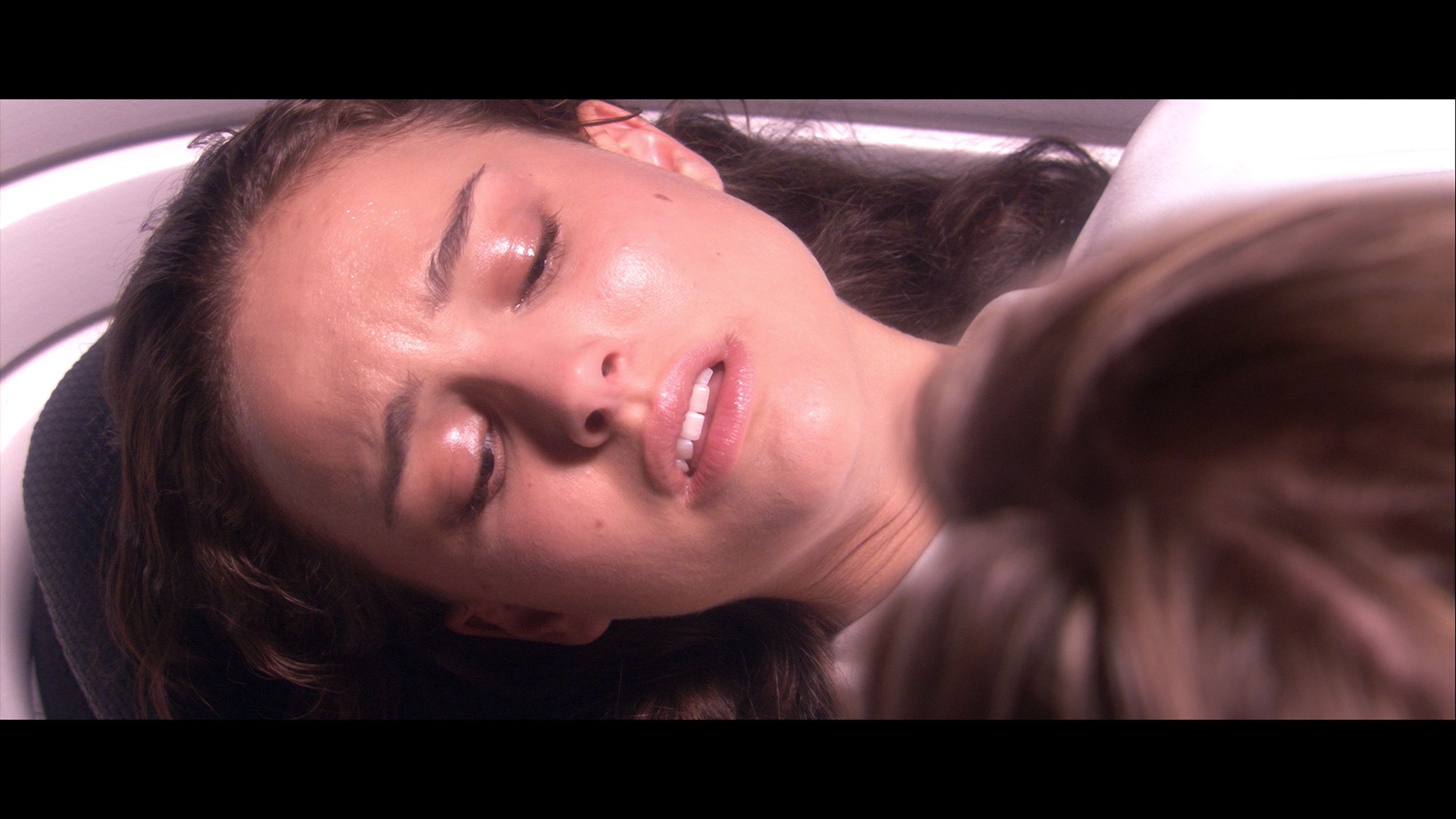
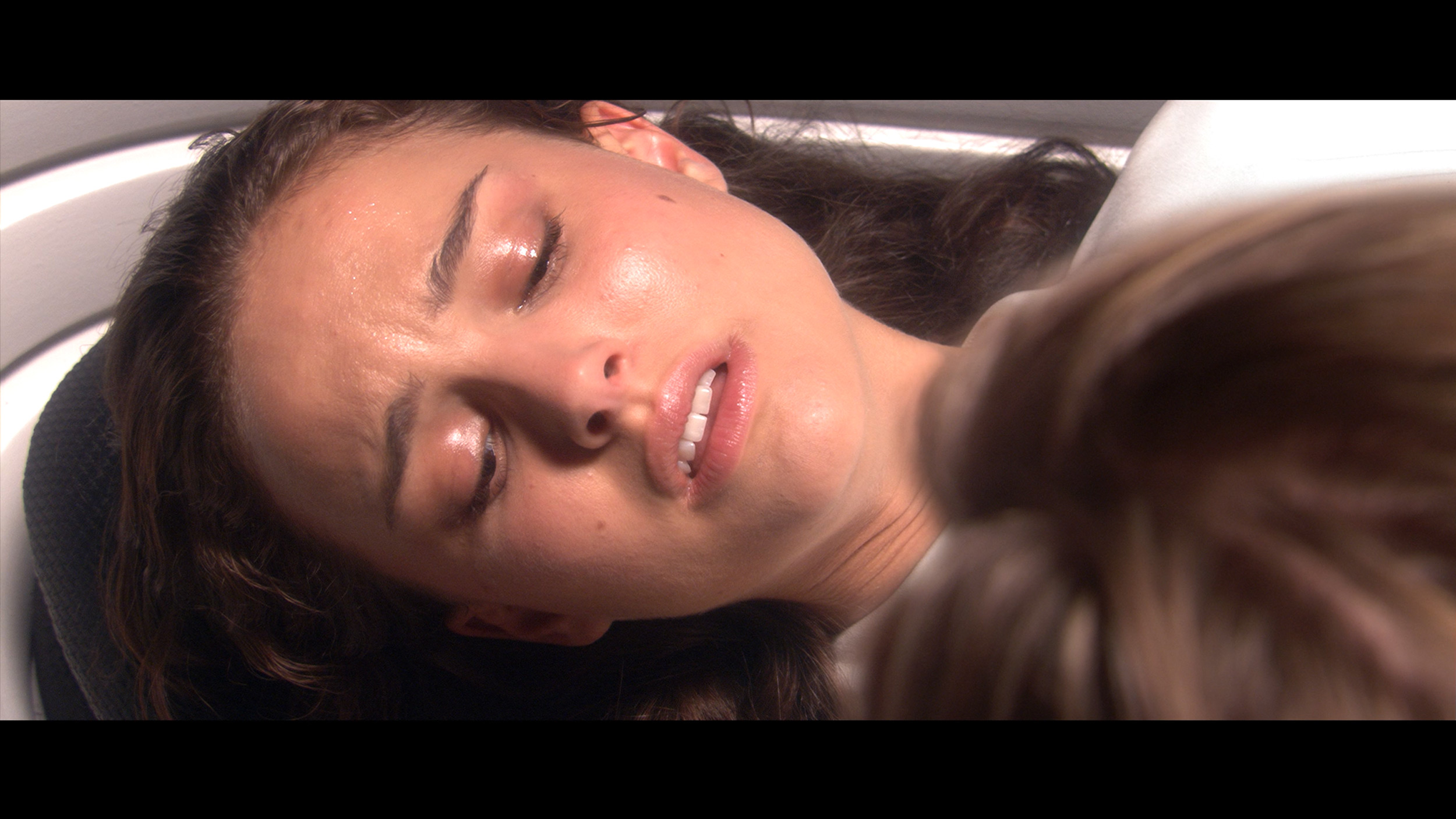
Factory Mode
After calibration
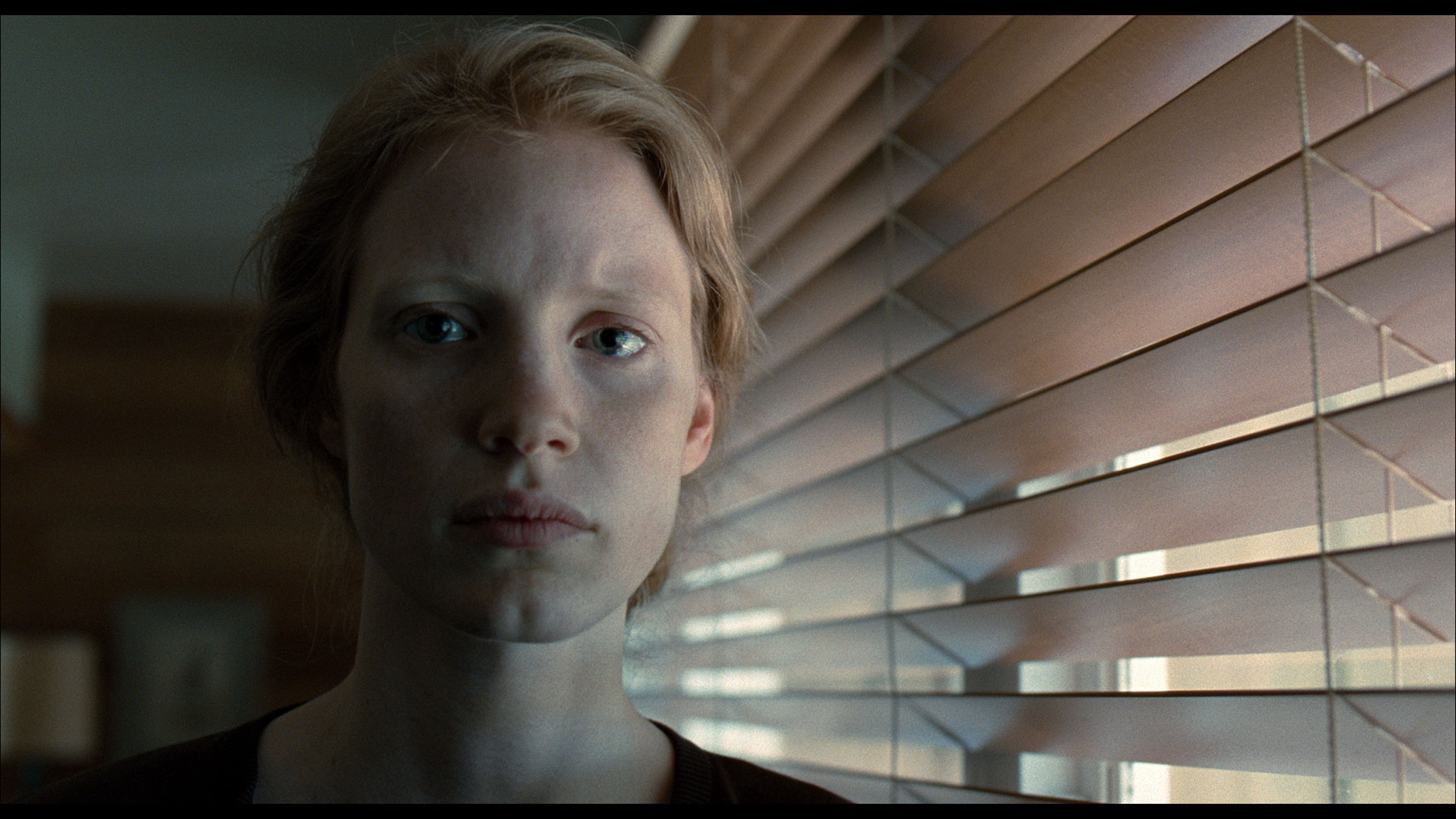
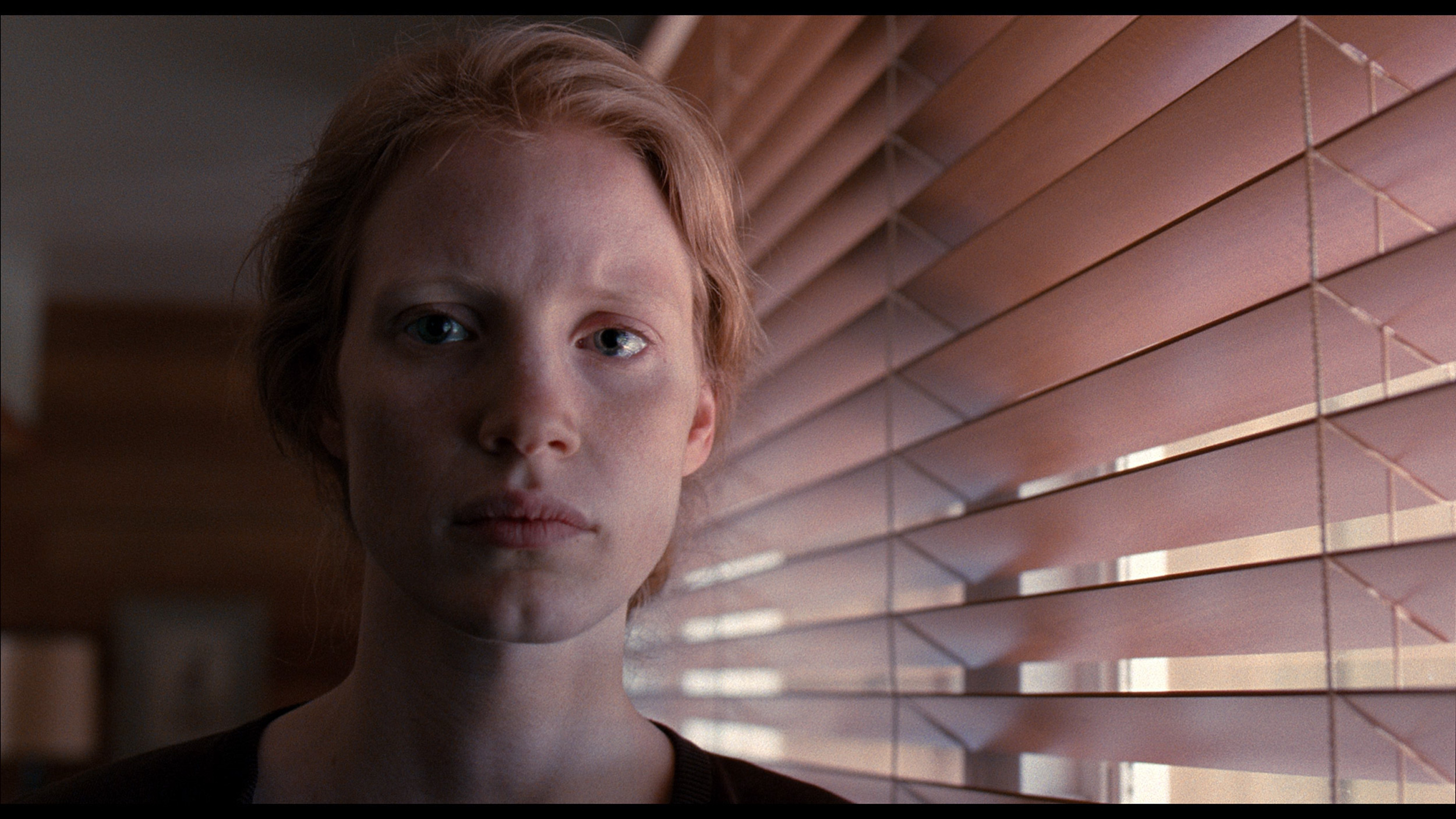
Factory Mode
After calibration
We decided to check the Filmmaker mode because it provided us with the best picture right out of the box. However, this does not mean it was perfect. The white balance had too much blue and red tint, causing the white to take on a slight purple-pink hue. Such an imbalance affected the visibility of practically all colors, as can be seen in the comparison photo below. The brightness characteristic in SDR content was quite well adjusted, although in HDR materials, we noticed that the television did not always manage its global dimming—at times, the screen was too dim, while at other times it suddenly brightened. Fortunately, issues related to colors can be effectively corrected with calibration tools, so we decided to get to work.
We started the color reproduction tests with the Filmmaker mode, which in theory should be the best choice right after taking the television out of the box. It certainly performs better than the Eco or Dynamic modes, which heavily interfere with the image and spoil its natural character. As you can see in the charts, the factory tuning of the V6C is not ideal, although it’s not a disaster either. The biggest problem turned out to be a lack of red – the television clearly "cools" the image, which is particularly noticeable on human faces, giving a "corpse skin" effect. This issue was the most bothersome in daily viewing. Looking at the color palette in HDR content, the deficiencies in red are also noticeable, and their source is the relatively narrow coverage of the color space. Of course, every television can be calibrated, so we decided to check how the V6C would perform after such an adjustment.
Color reproduction after calibration
7.8/10
5.2/10

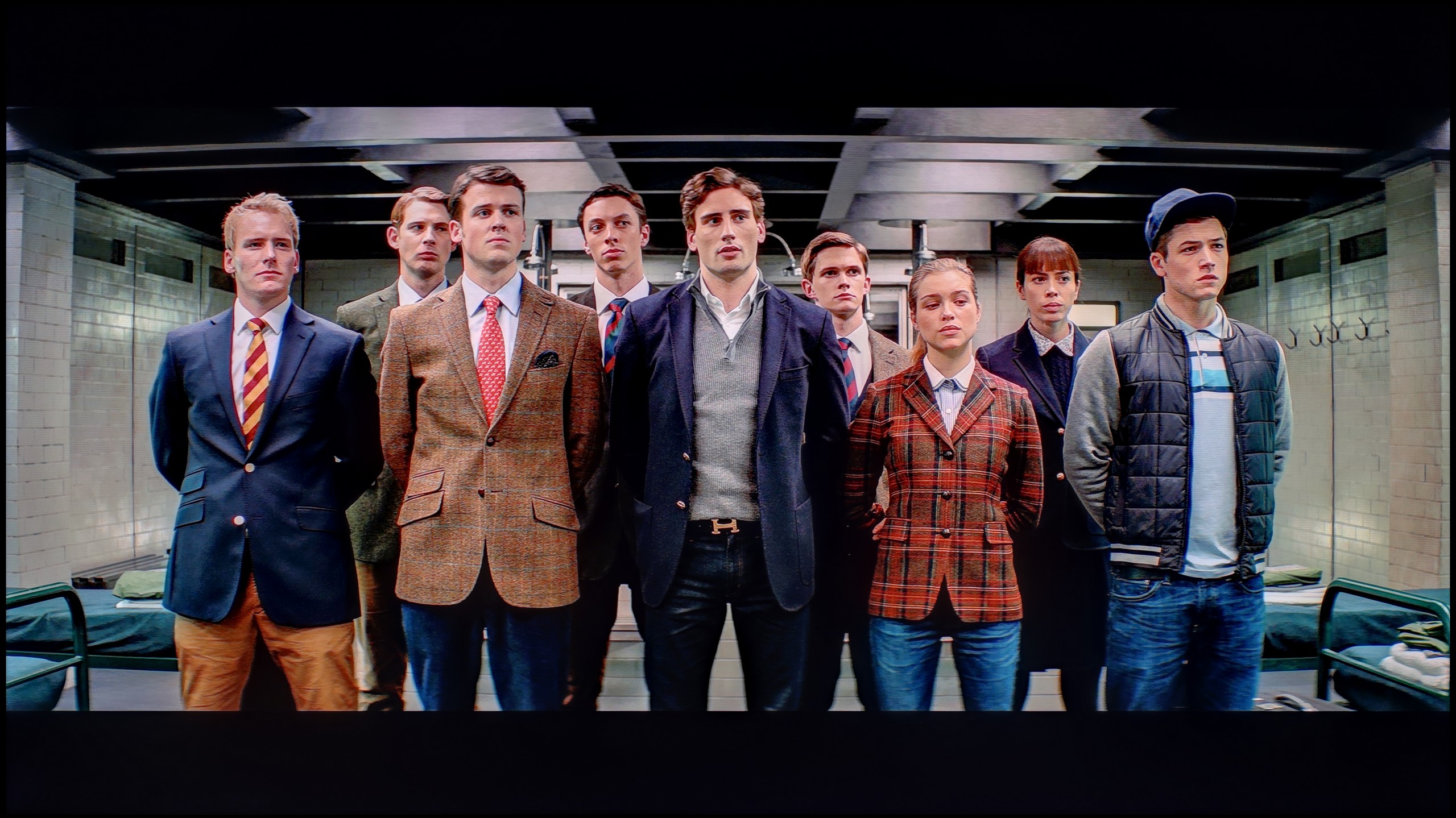


After calibration, we managed to correct the white balance almost to perfection. Older SDR content looks stunning — most errors are within a threshold of 2, which is definitely below the human eye's perception limit. In HDR, we also brought the white balance to the correct level, but a different problem arises here. So why are there still relatively large errors in color reproduction? This is mainly due to the limited color palette and the way the television manages brightness. The applied global dimming technique does not give the user control in the settings, so when analyzing the EOTF curve in HDR films, it is clear that the Q8F can independently modify luminance. This can be considered a certain limitation, but despite this, the image after calibration is still much more enjoyable than in the factory version.
My dear friends – we haven't had such a difficult "calibration battle" in years. The V6C turned out to be one of the most stubborn TVs we've dealt with in the editorial office. The calibration trials alone took us several working hours and required a lot of patience. We finally managed to slightly warm up the skin tones, which made the faces stop looking like they were straight out of a horror film, a flaw in the factory settings. Unfortunately, that's not the end of it – the TV reacted to our adjustments in white balance in a completely unpredictable way. Where we expected image stabilization in a given area, new errors appeared, and the Color Checker measurements showed deviations that couldn't be rationally explained. It's hard to say whether the software or the construction itself was to blame, but one thing is certain – the V6C offered exceptionally strong resistance. In the end, the calibration brought improvement, especially in SDR content, where the image became more pleasant and natural. However, it must be clearly stated that the design limitations remained. The TV still flattens the image in HDR material and has significant deficiencies in color reproduction. This is equipment rather intended for everyday TV watching or SDR materials than for cinematic screenings in the highest quality.
Smoothness of tonal transitions
9/10
7/10




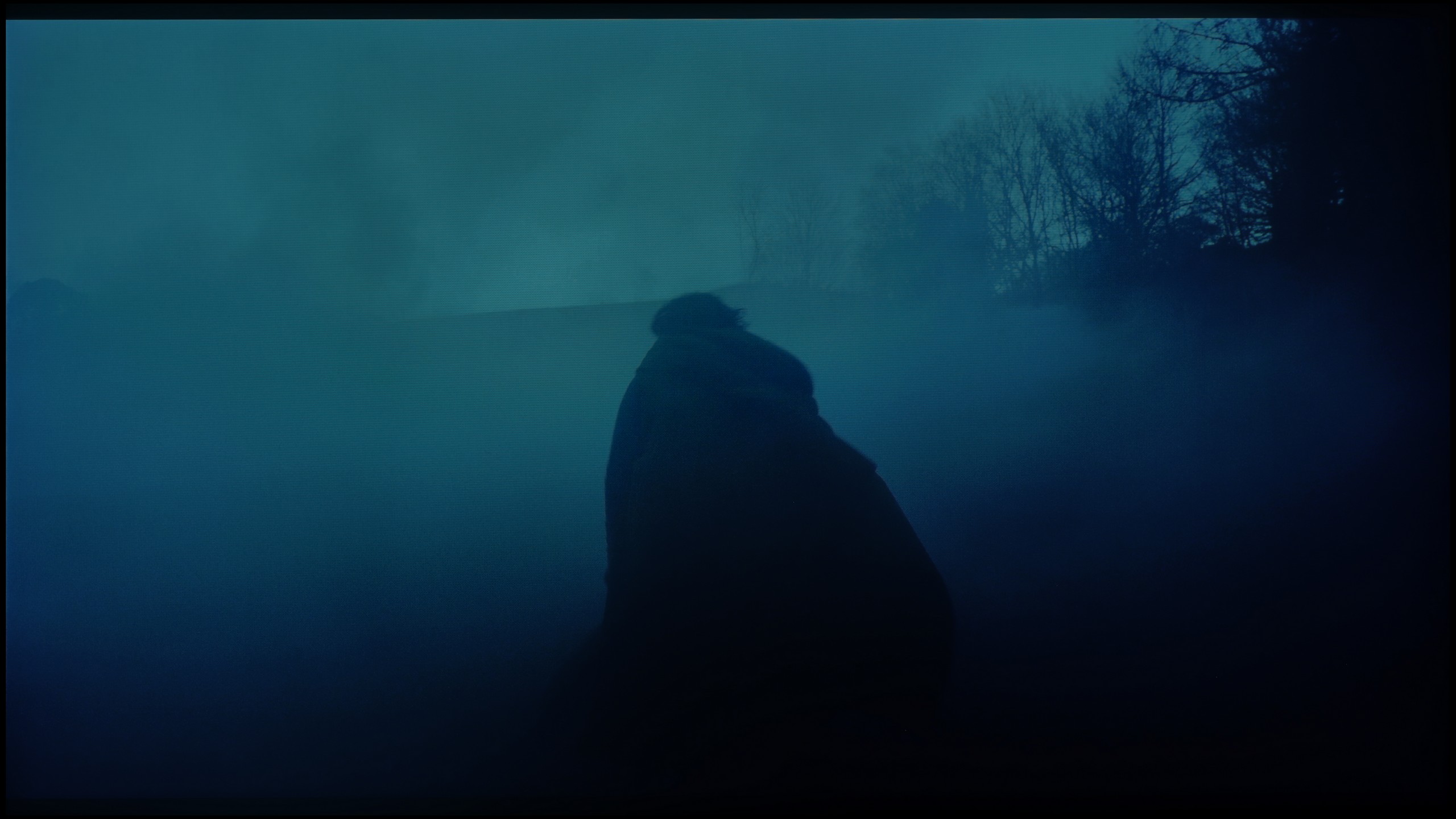







The fluidity of tonal transitions in the Q8F is really very good. The TV blends colors very nicely, both in bright segments of the sky and in darker shots, where "steps" in color can easily be visible. Yes, there are occasional errors, but you have to look closely to catch them. In practice, while watching movies or series, the picture looks cohesive and is not distracting with any artifacts. Therefore, the rating in this category had to be high. 😉
When it comes to the smoothness of tonal transitions, in everyday viewing it doesn't look too bad. In most scenes, the image appears smooth, and the colors blend without noticeable interruptions. You can comfortably watch movies or series without worrying about glaring artifacts. The problem begins only in more extreme moments – in very bright or exceptionally dark scenes, V6C shows its limitations. You can then see subtle "banding" of colors, meaning a lack of perfectly smooth transitions. Fortunately, these situations are rather sporadic.
Image scaling and smoothness of tonal transitions
5/10
5/10
Smooth transition function
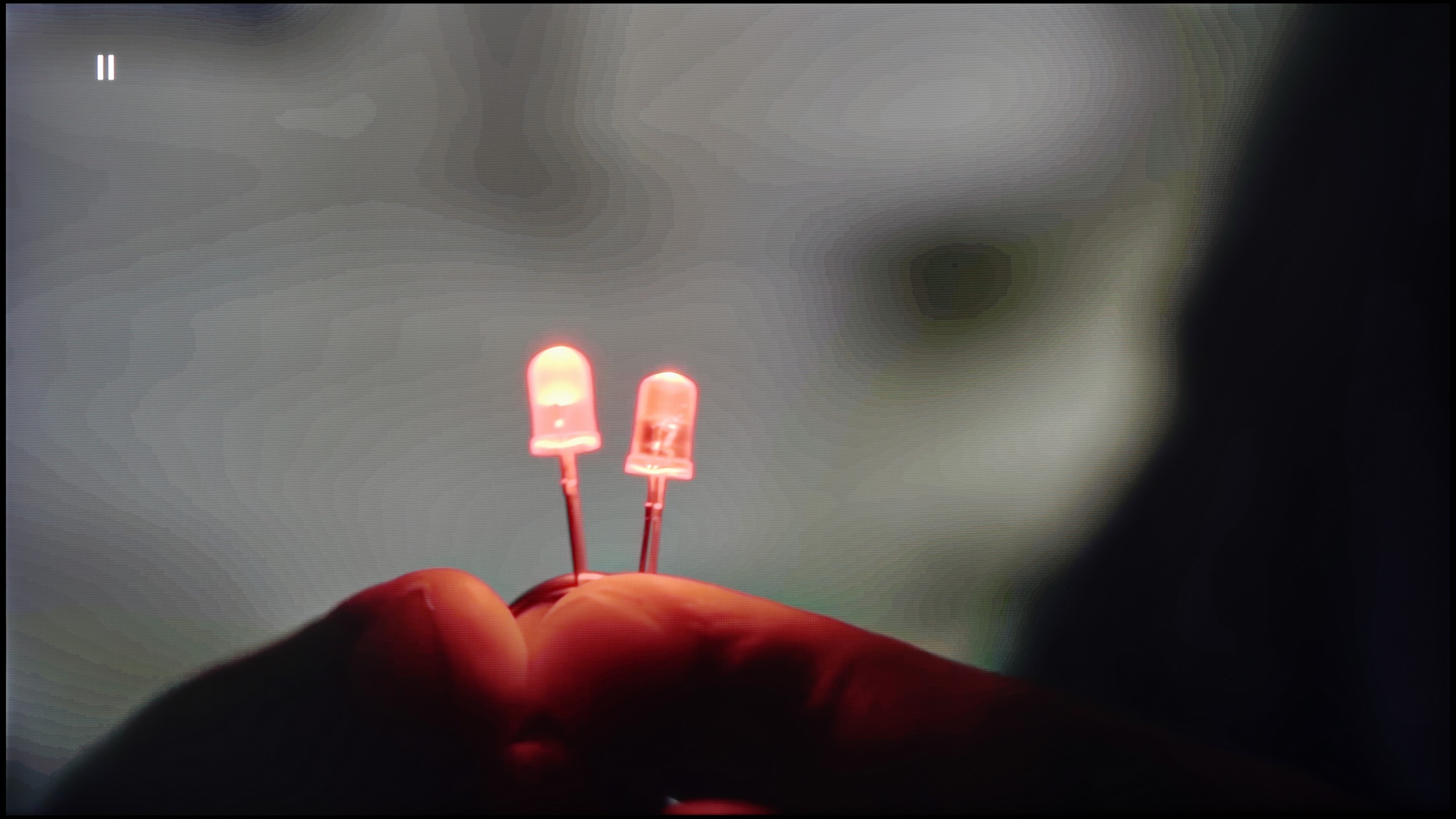

Image without overscan on the SD signal


Let's see how the Q8F handles older content, which often has poor quality. Let's start with the positives: the upscaling, which means raising the image to a higher resolution, works really well. The TV handles both classic television and materials from YouTube without giving the impression that we are dealing with something completely unattractive. Materials in very low resolutions, such as 576p, perform worse — the image can be cropped, and unfortunately, the overscan phenomenon cannot be turned off. However, the digital processing itself looks worse too. The noise reduction function, instead of removing unwanted interference, smooths out almost everything: film grain (which is desirable for many viewers) disappears along with the texture of the image, and the faces of the actors begin to resemble characters from cheap Turkish soap operas. It is therefore hard to consider this option useful — it's best to leave it completely turned off. Perhaps Samsung will refine the operation of this feature in updates, but for now, it’s difficult to regard it as anything other than an unnecessary addition.
When it comes to upscaling, the V6C does not bring anything groundbreaking. Lower quality content is heavily sharpened, making the image look very unnatural, sometimes even artificially. This can be partially mitigated by lowering the sharpness level in the settings, but the effect is not spectacular. The image still remains far from ideal. The digital processing itself performs better. The function responsible for smoothing tonal transitions works quite effectively, especially at the medium setting, where the image indeed appears smoother. Unfortunately, its operation is quite aggressive – it heavily interferes with the overall scene, causing the actors in the foreground to start looking like characters from super smooth telenovelas. Therefore, we would not recommend using this option if natural reception of the image is important to us.
Blur and motion smoothness
4.5/10
3/10
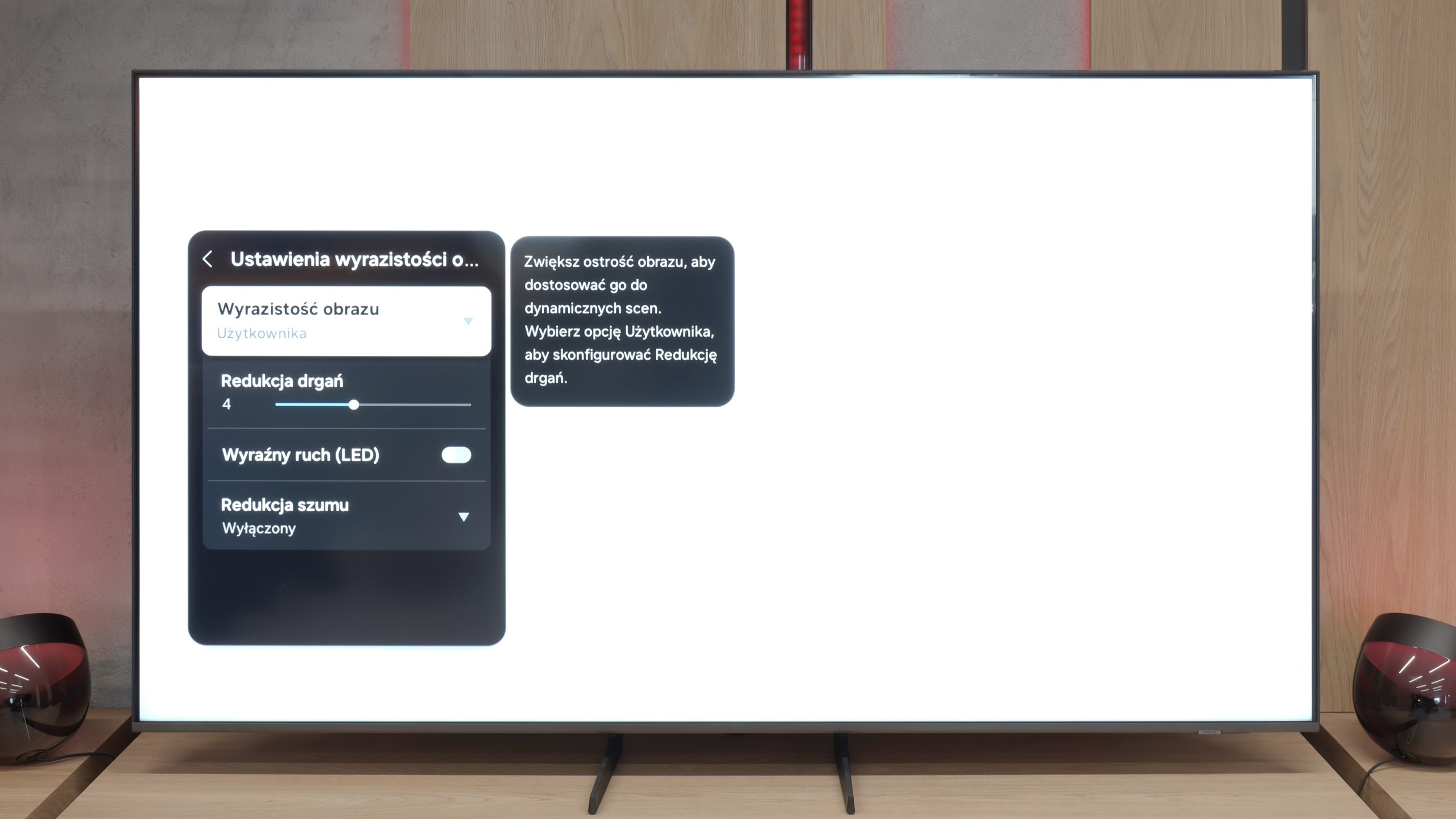
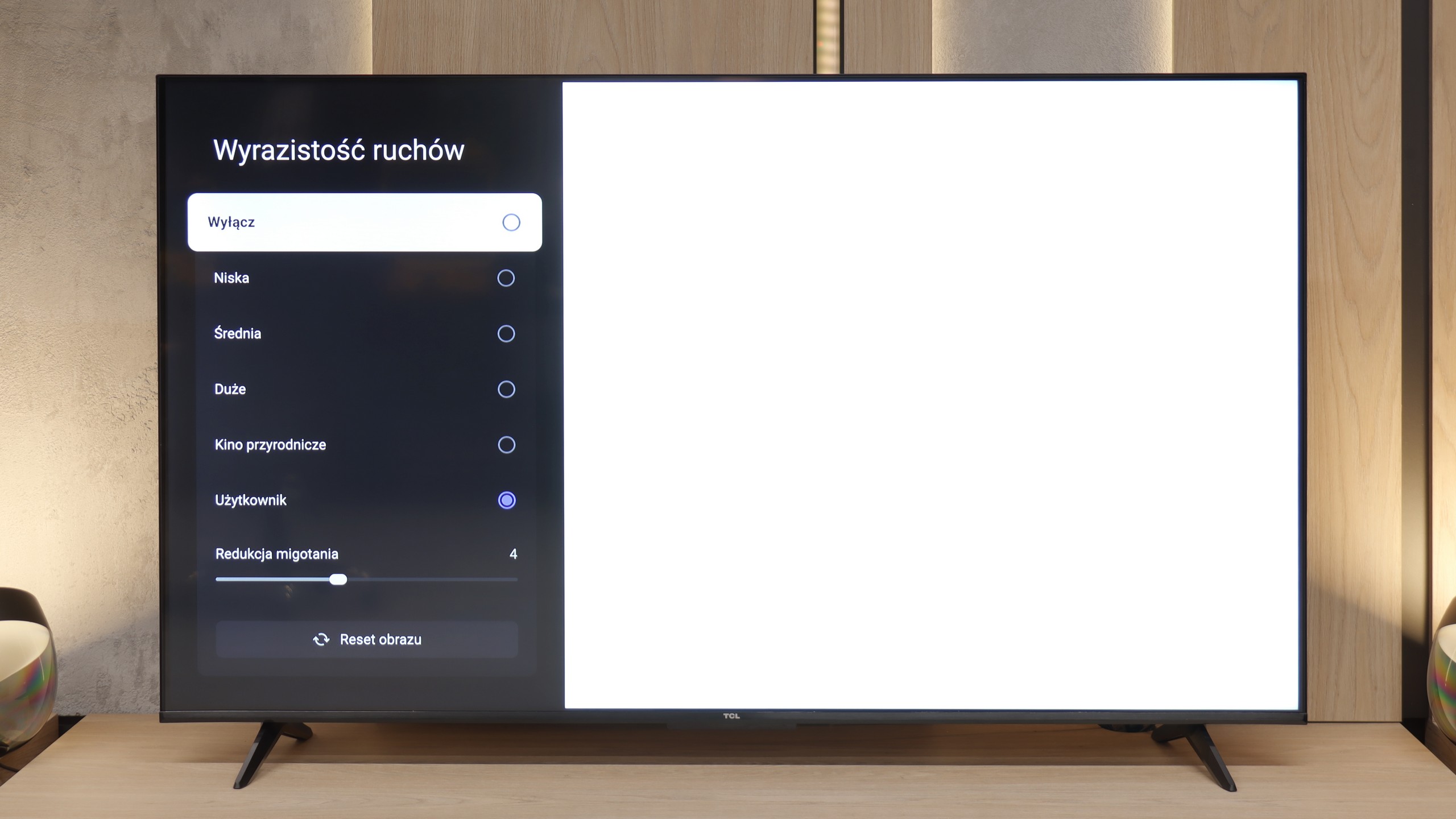
Blur (native resolution, maximum refresh rate):

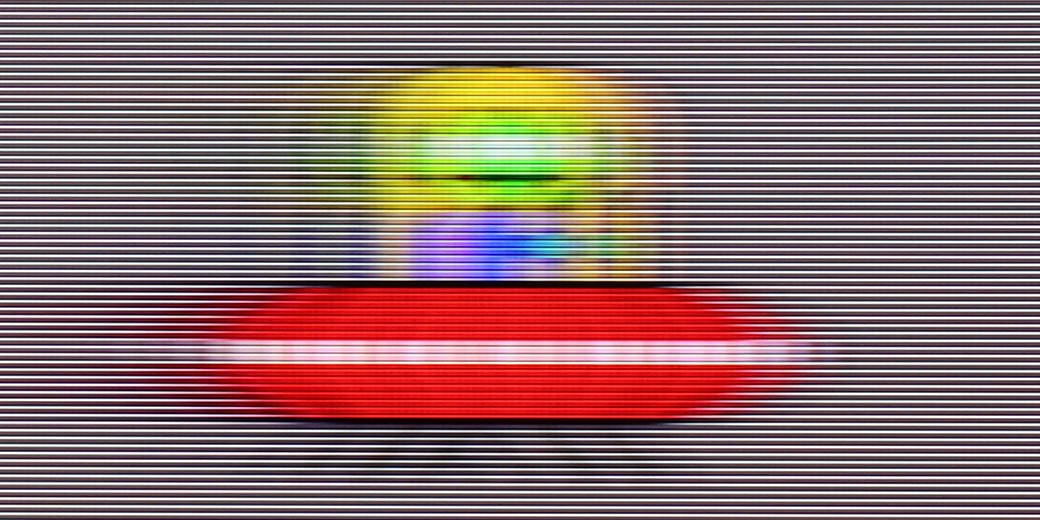
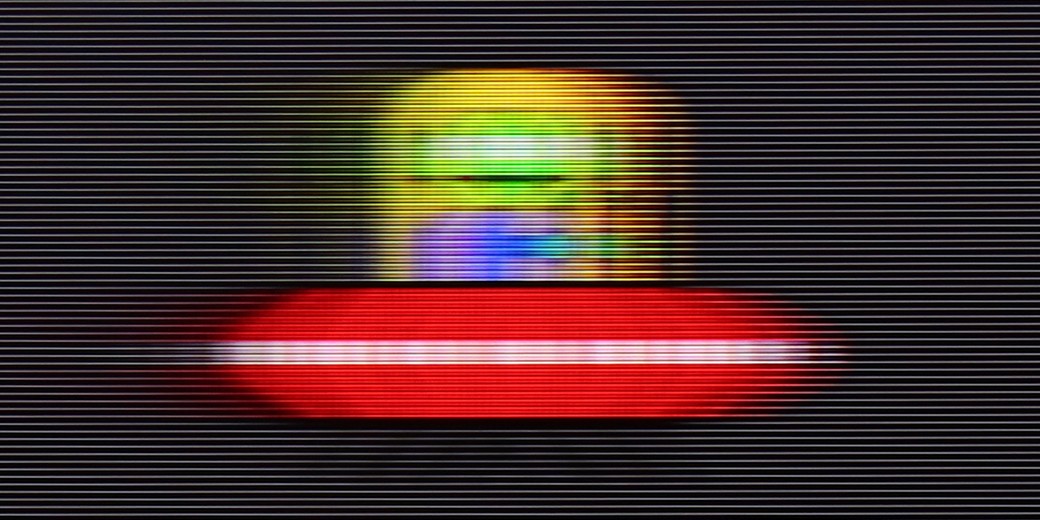
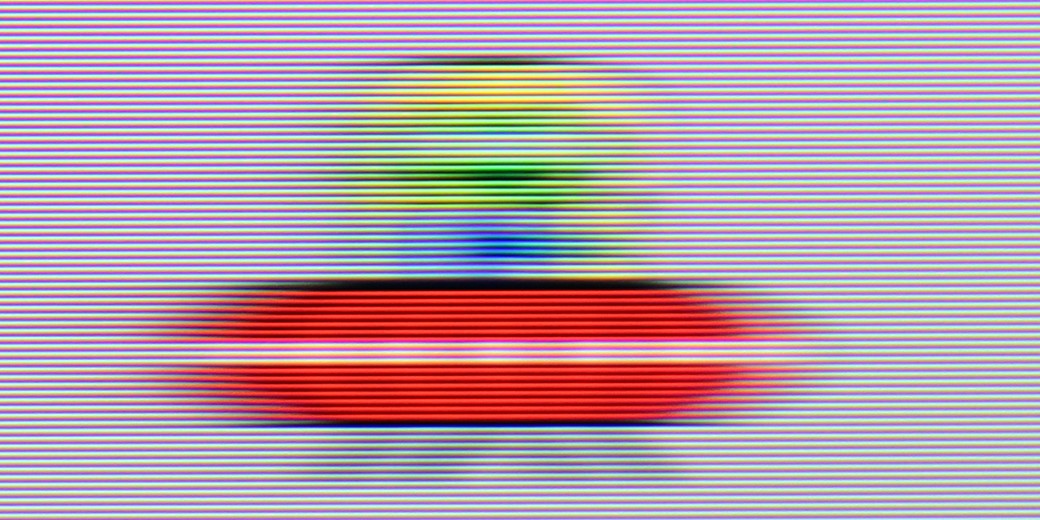
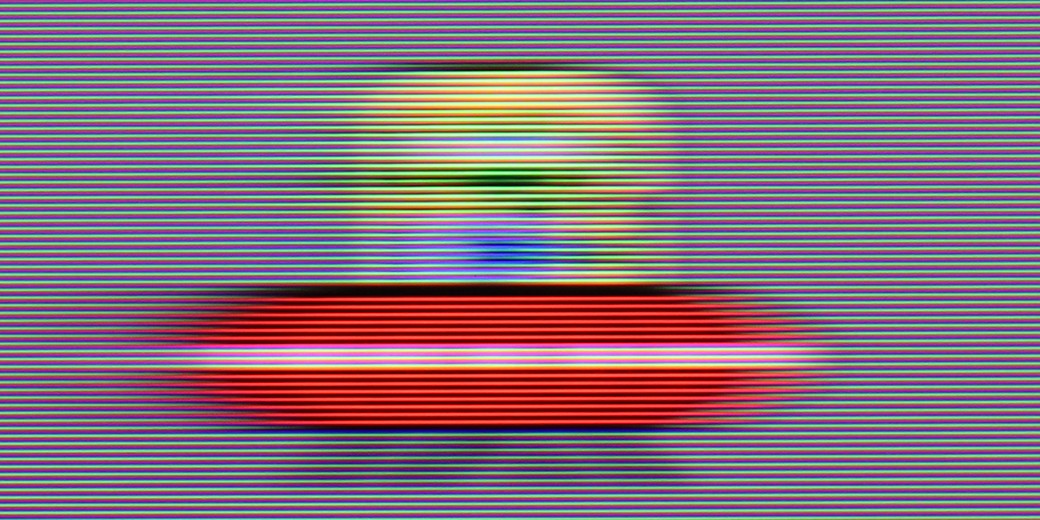

Blur (BFI function enabled):



Due to the 60 Hz panel, it's hard to call the Q8F a television made for gaming or watching sports. The panel isn't particularly fast, making motion blur clearly visible. If you were counting on spectacular, almost "stadium-like" experiences during broadcasts, you might feel a slight disappointment. Fortunately, in the case of movies and series, Samsung has not abandoned motion smoothing features. This is nothing other than a motion smoother that allows improving the fluidity of productions recorded at 24 or 30 frames per second. Thanks to this, one can decide whether they prefer a smoother, "television" image or to maintain a cinematic quality. It all depends on the viewer's preferences, and the ability to adjust this parameter is undoubtedly a plus.
Motion smoothing and motion fluidity is an area where the V6C quickly reveals its limitations. It is a 60 Hz TV, so it was hard to expect miracles here. In dynamic sports scenes, the picture comes off rather average. This is most noticeable in darker scenes, where clear smears and blurry "halos" trail behind moving objects, which can be quite distracting. This is definitely a weaker point of this model. Fortunately, there is also a small plus. The V6C is equipped with motion interpolation, which works while watching movies. Thanks to it, productions recorded at 24 frames per second, meaning practically all cinematic titles as well as series, can look smoother than they were actually recorded. Importantly, the intensity of the effect can be adjusted to personal preferences – from slight smoothing to full "soap opera effect."
Console compatibility and gaming features
3.7/10
4/10
- ALLM
- VRR
- VRR range
- Dolby Vision Game Mode
- Correct implementation of HGIG
- 1080p@120Hz
- 1440p@120Hz
- 4K@120Hz
- Game bar
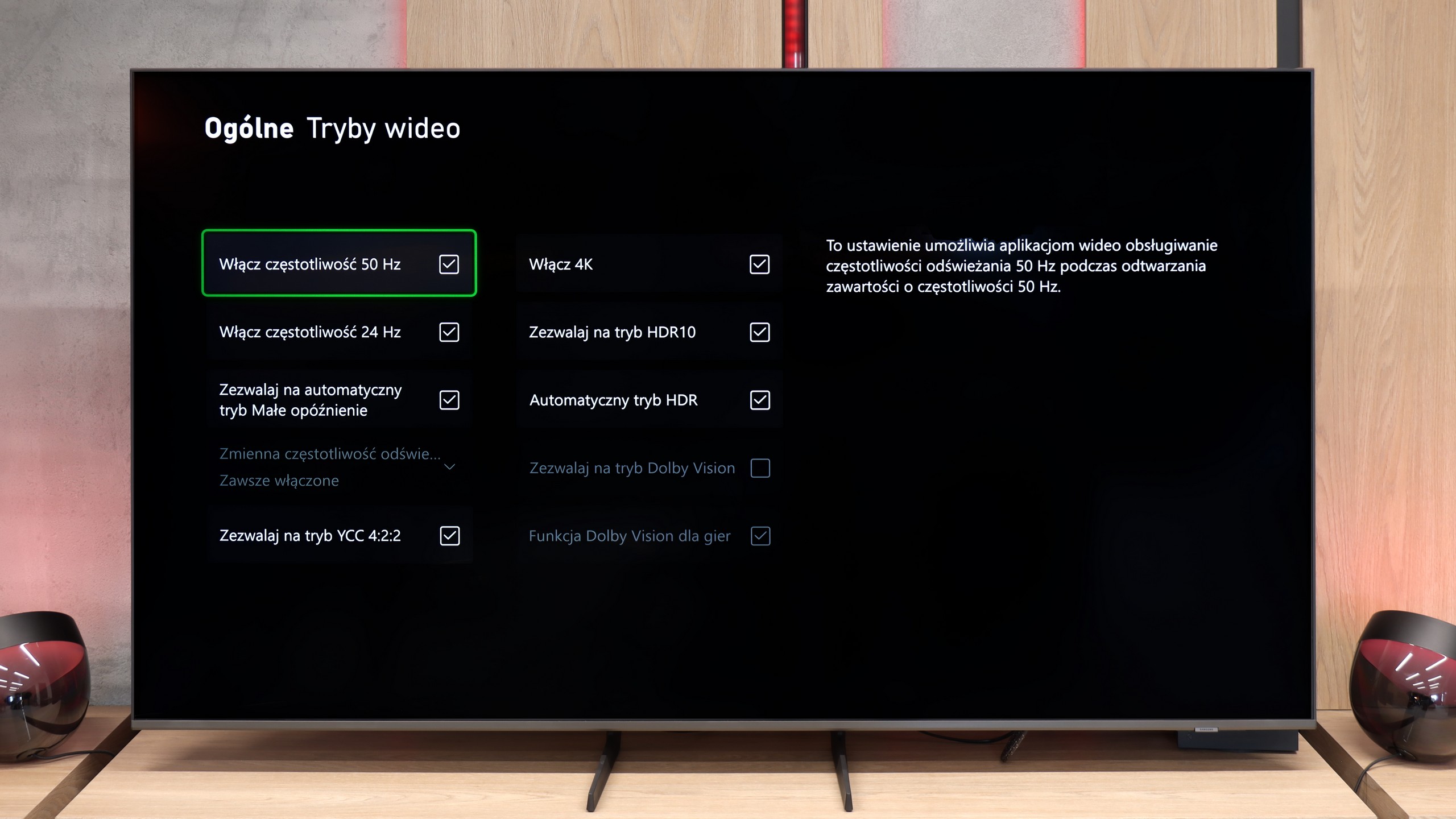
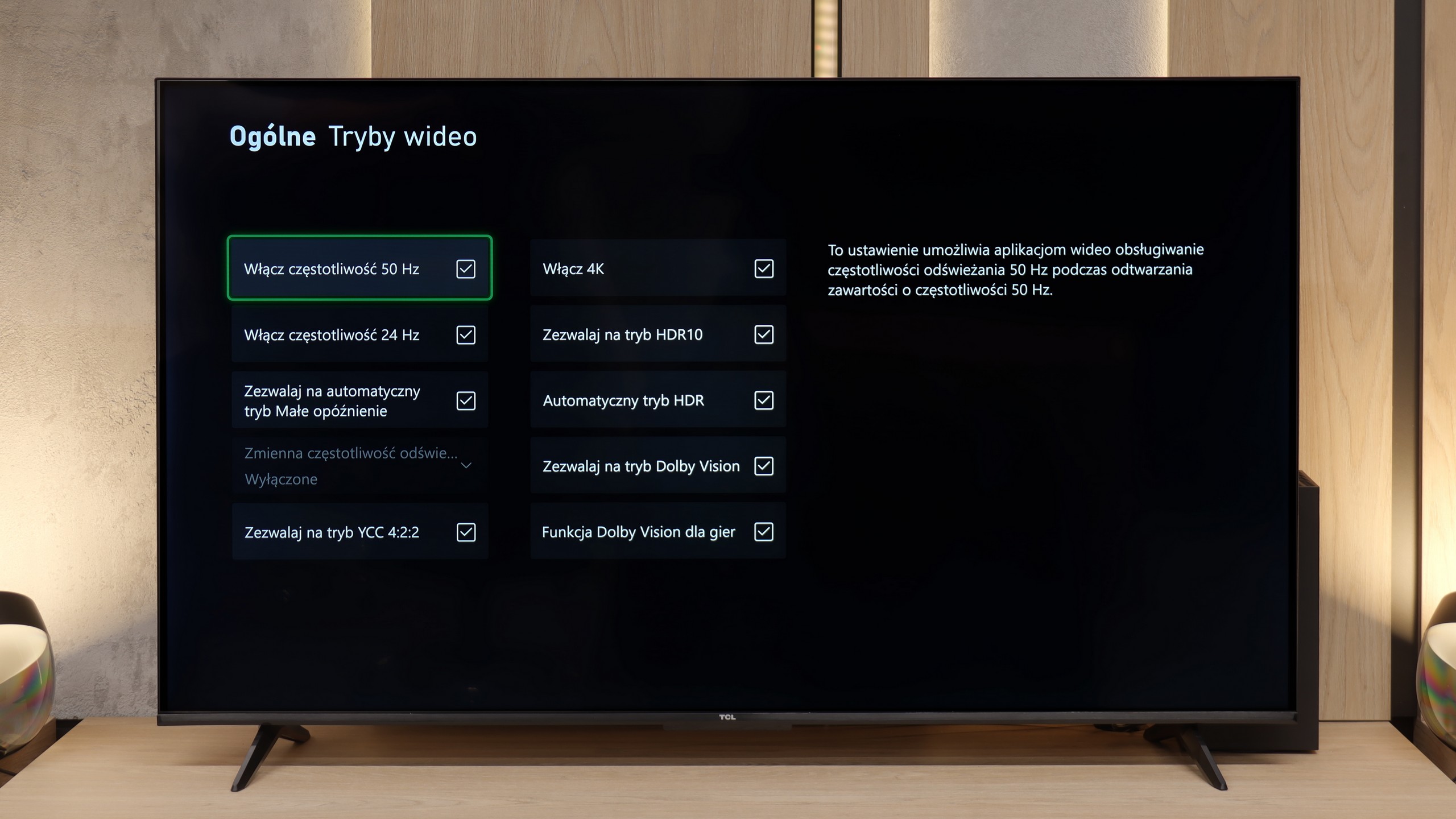
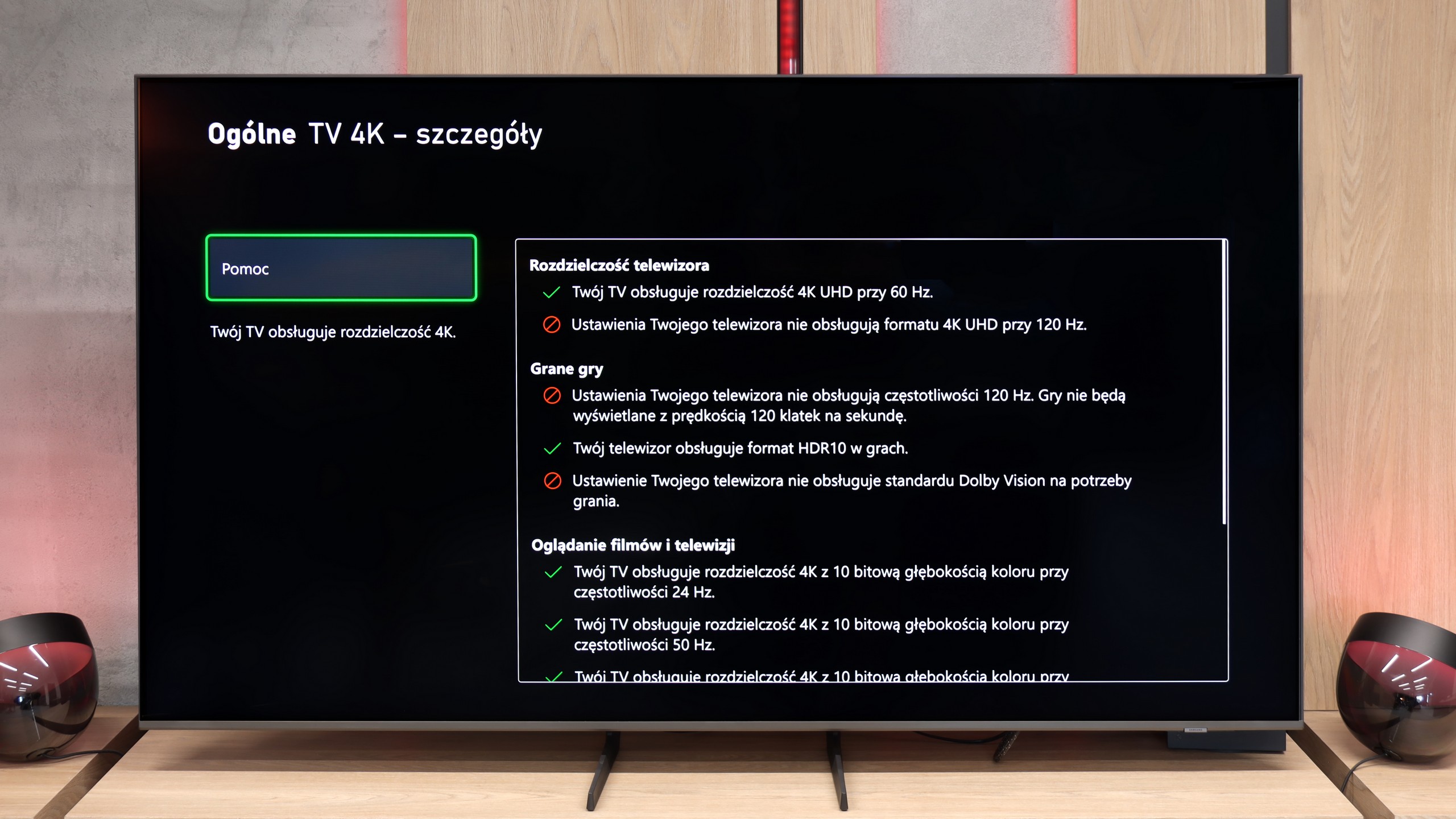
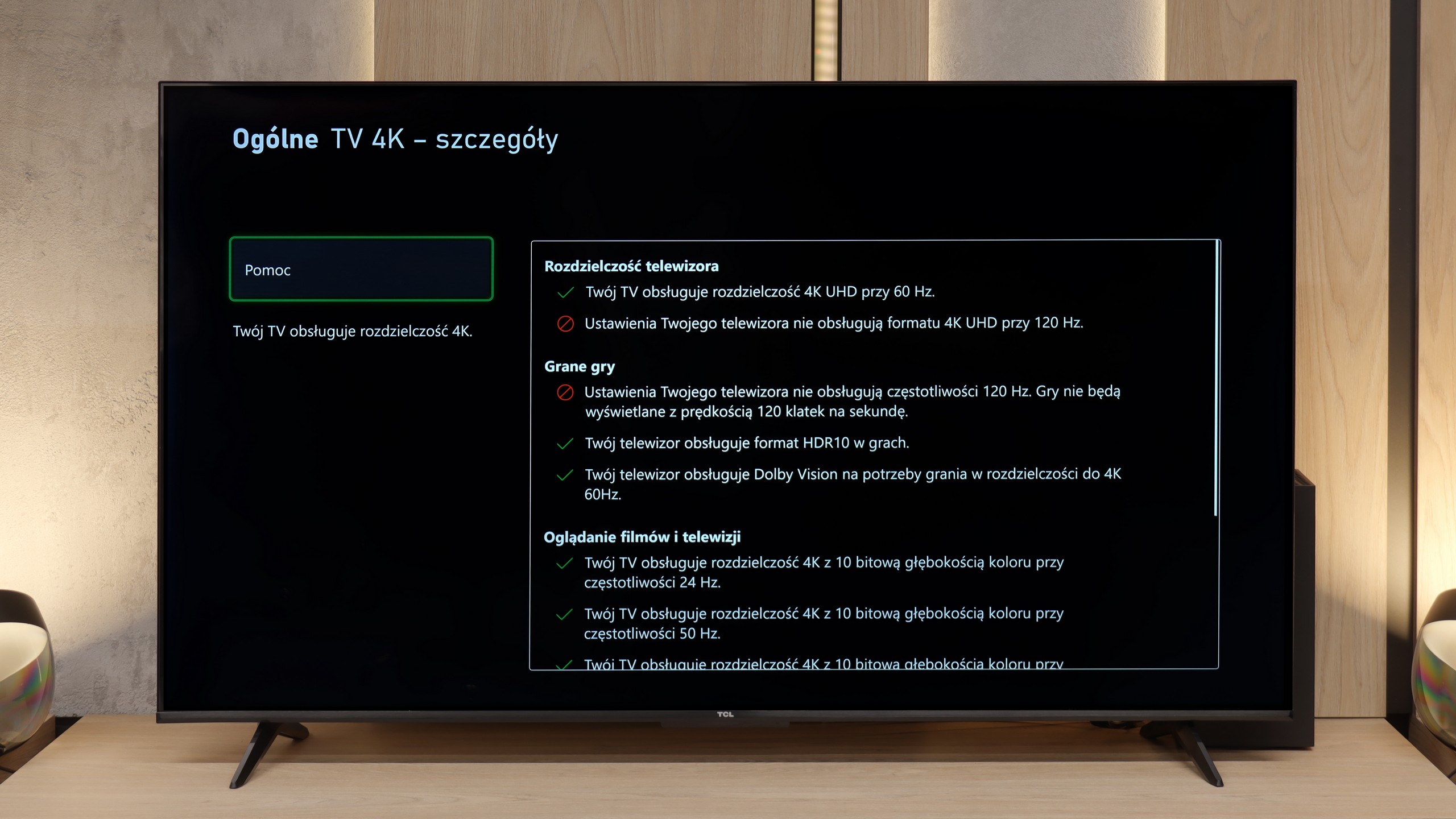
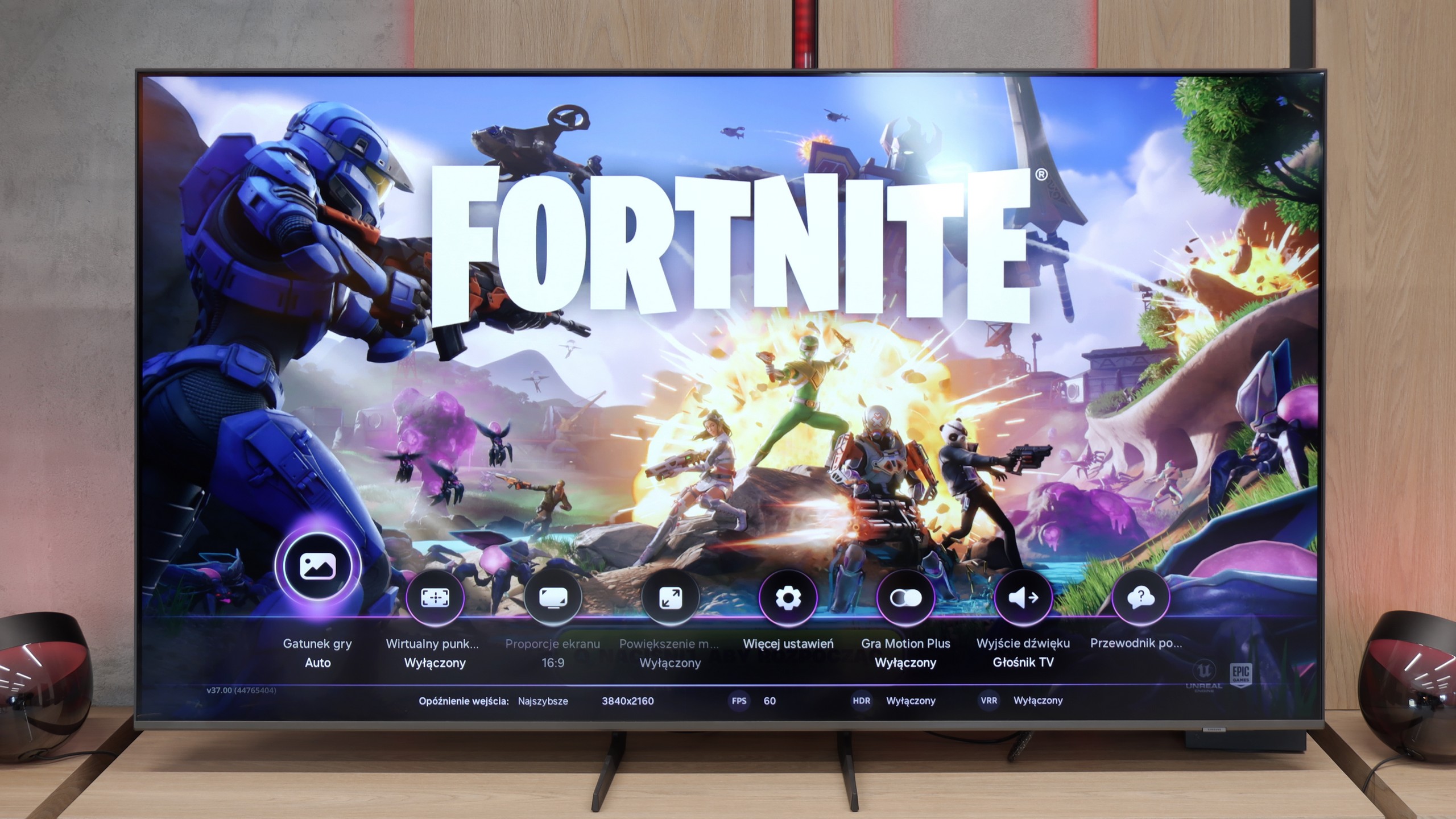
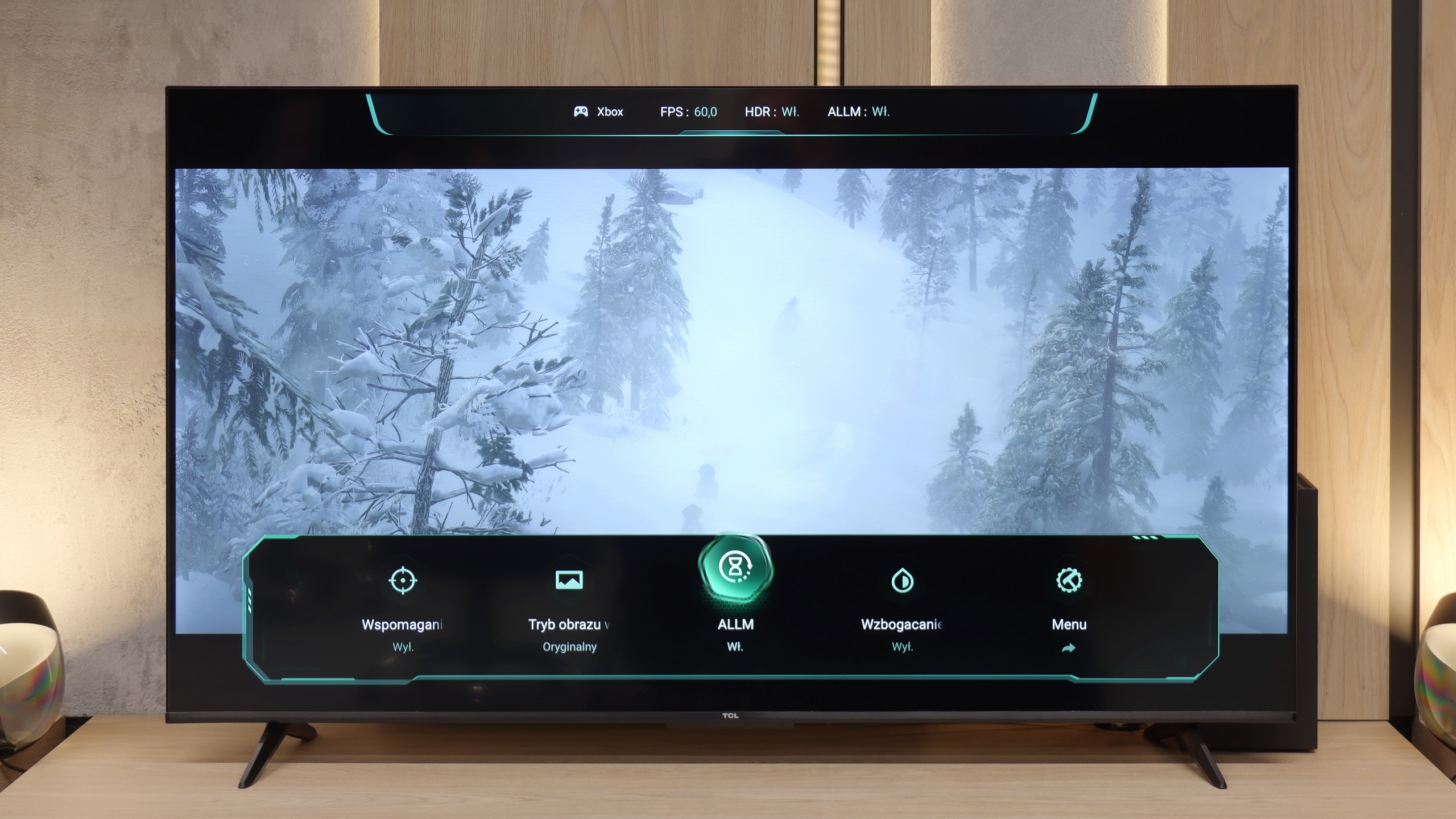
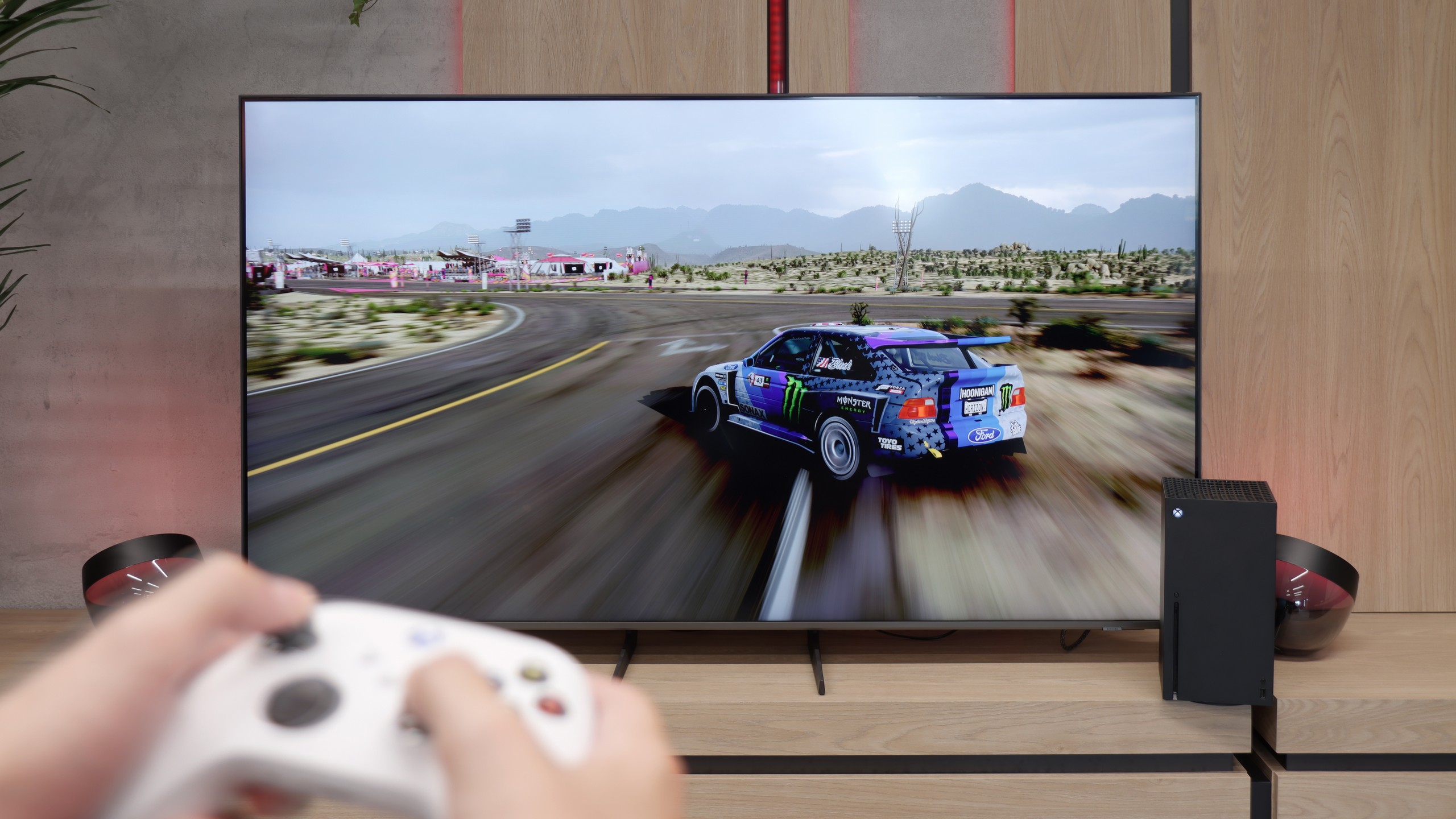
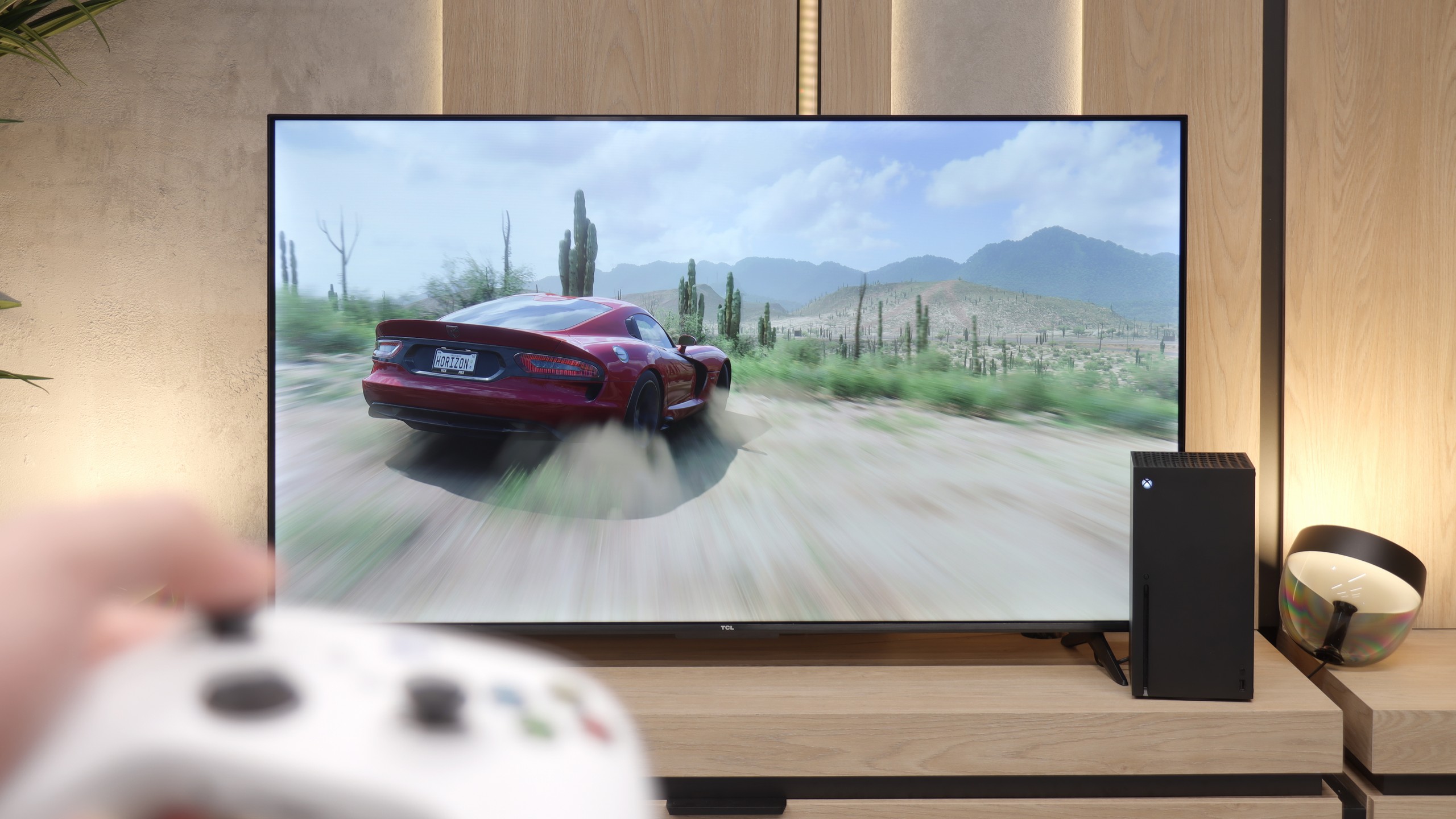
It is not entirely clear what Samsung has mixed up this year with its televisions, but the Q8F is not free from all the confusion with updates and shortcomings. While its older cousin, the Q67D, could still be recommended to casual gamers with a clear conscience, it's hard to find a reason to do so here. Aside from the automatic game mode and the attractively designed Game Bar, we practically get nothing that could attract gamers. The lack of proper HGiG implementation is a big problem, especially since function simply disappeared after the 1126 update. The issue with VRR is even worse. Although it is featured in the manufacturer's brochures and appears in the Game Bar, we couldn't activate it. The Xbox Series X console did not allow it to be activated at all, and the option remained grayed out and inactive. It's hard to praise such a television even to casual gamers, which is a shame because Samsung has had a strong bargaining chip in the gaming segment for years.
Although the V6C is not a television designed with avid gamers in mind, TCL has included a few features that may appeal to more casual users. There is no 120 Hz panel or HDMI 2.1 ports, but there is an ALLM mode that automatically switches the TV to low-latency mode. Additionally, there is a quite practical Game Bar – a simple panel that allows you to view basic parameters, change the picture mode, or even enable a virtual crosshair on the screen. An interesting feature is also the support for Dolby Vision Gaming, intended for Xbox Series S/X consoles – a nice addition, though in practice it doesn't offer as much as in more expensive models. However, the biggest problem remains HDR configuration. The HGiG feature, which adjusts the brightness and contrast of games to the panel's capabilities, does not respond as we would expect – the image can end up being overly dark or too flat. As a result, a better solution turns out to be simply playing in SDR mode, where the V6C performs stably and does not try to pretend to be an HDR TV.
Input lag
9.9/10
10/10
SDR
HDR
Dolby Vision
Fortunately, when it comes to gaming, Samsung didn't try to "enhance" anything, and the input lag remained at an excellent level. Results oscillating around 10–15 ms mean that the delays are practically imperceptible. The controls are instant, and the responses from the console or computer appear on the screen with no noticeable delay. In this regard, the Q8F performs exceptionally well, and it's hard to find any faults with it.
The input lag measurement indicates values below 15 ms, which is a level that is practically difficult to catch with the naked eye. Even in dynamic games, the action remains responsive, and the controls are smooth. This is a result that can confidently be considered very good and comfortably sufficient for most gamers, even if the V6C is not strictly gaming hardware.
Compatibility with PC
6/10
4/10
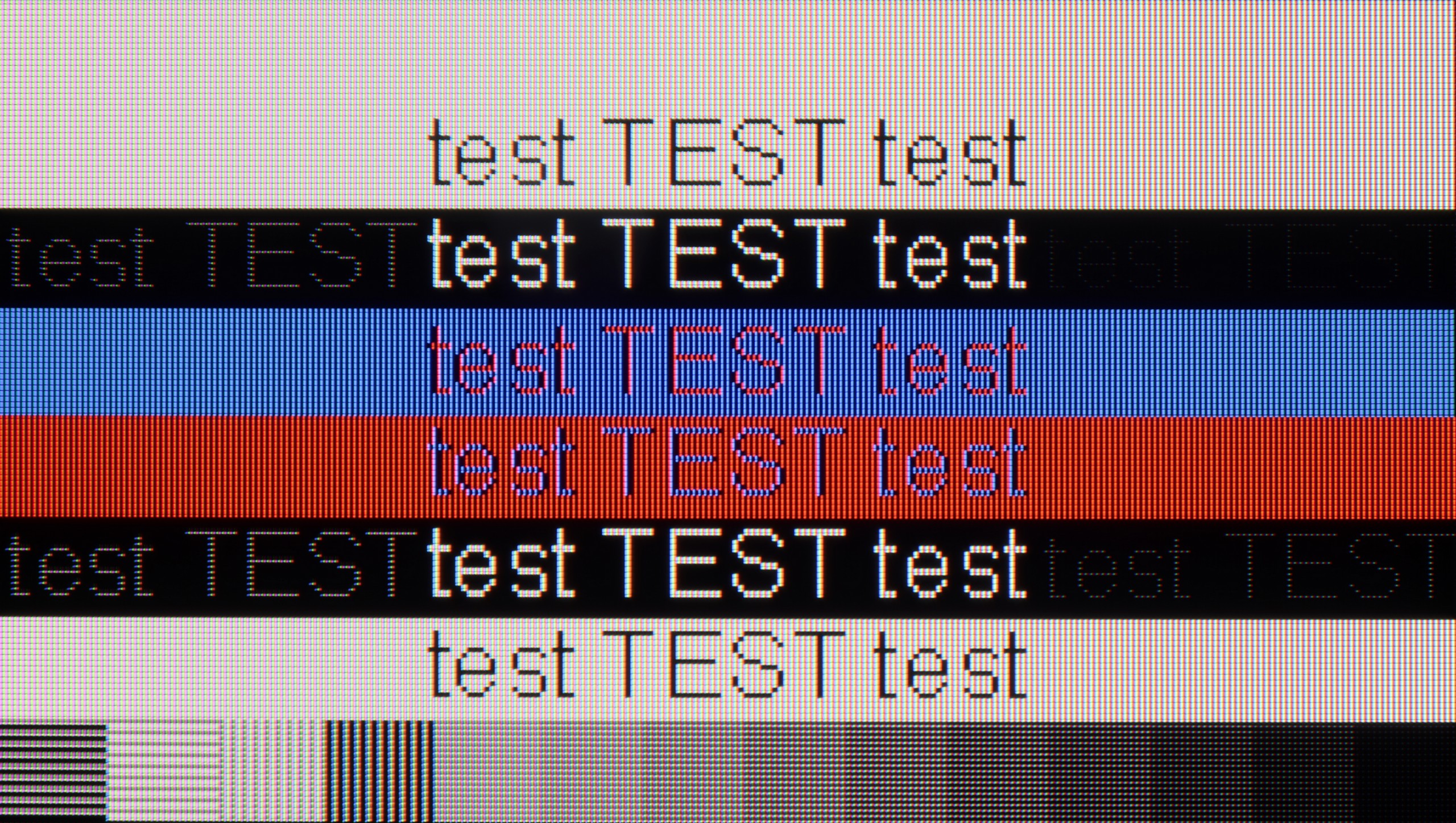
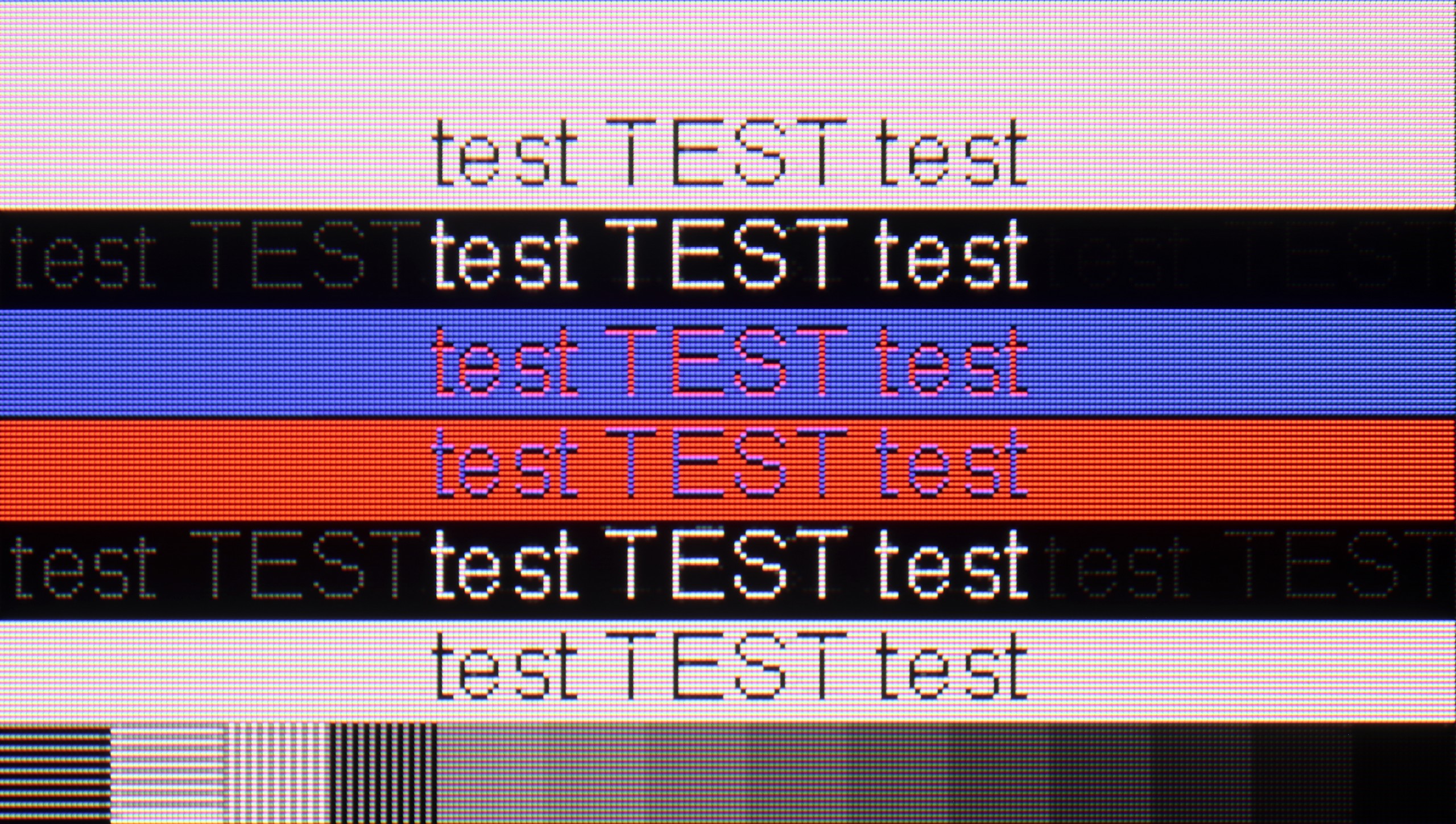
Although playing on the Q8F is not particularly attractive — it lacks modes with lower resolutions and higher refresh rates, and there are issues with VRR (G-Sync) along with a matrix limited to 60 Hz — as a work monitor, the television performs excellently. The readability of fonts is at a very high level, so working with text or spreadsheets in Excel is a pure pleasure. In this regard, the Q8F can be a real alternative to a large office monitor.
Cooperation with the PC is only partially satisfactory. The TV supports chroma 4:4:4, so at first glance, the fonts look quite decent. The problem arises only when we take a closer look – under a microscope, it turned out that TCL used an unusual subpixel arrangement in the V6C. Instead of the classic vertical arrangement, we have a horizontal layout here, which in practice causes various artifacts and inconsistencies in displaying letters. As a result, the fonts can appear jagged, and after prolonged use, the text can strain the eyes. Therefore, it’s hard to consider the V6C a viable substitute for a monitor – it’s suitable for occasional browsing or watching content from a computer, but it completely fails as a main screen for work. There’s also not much to say about gaming features, as we simply won’t find any.
Viewing angles
3.4/10
2.9/10
The viewing angles on the Q8F can be described as average, which stems from the use of a VA panel. When watching the TV straight on, the image looks very good, but as soon as you shift a bit to the side, it starts to fade and lose contrast. The colors gradually lose saturation, and black takes on a grayish hue. This is a typical limitation of this type of panel, and it's hard to expect miracles here. Compared to IPS panels, the difference is clear — although they are weaker in contrast, they maintain color consistency better at an angle. The Q8F performs best in a classic setup, where viewers sit directly in front of the screen. If you plan on watching with a larger group, with people spread out more widely in the living room, the effect may not be as satisfying.
Viewing angles in the V6C are a classic compromise that we know from VA panels. We gain solid black when viewing straight on, but just moving slightly to the side causes the image to noticeably lose quality – colors fade, and contrast drops. This is a typical limitation of this technology and is unlikely to surprise anyone who has dealt with televisions before. In practice, this means that the V6C performs best in a "one sofa" setup – when we watch straight in front of the screen, the black looks decent, but a larger group of viewers spread throughout the living room will quickly notice differences in the displayed image.
Daytime performance
5.6/10
3.6/10
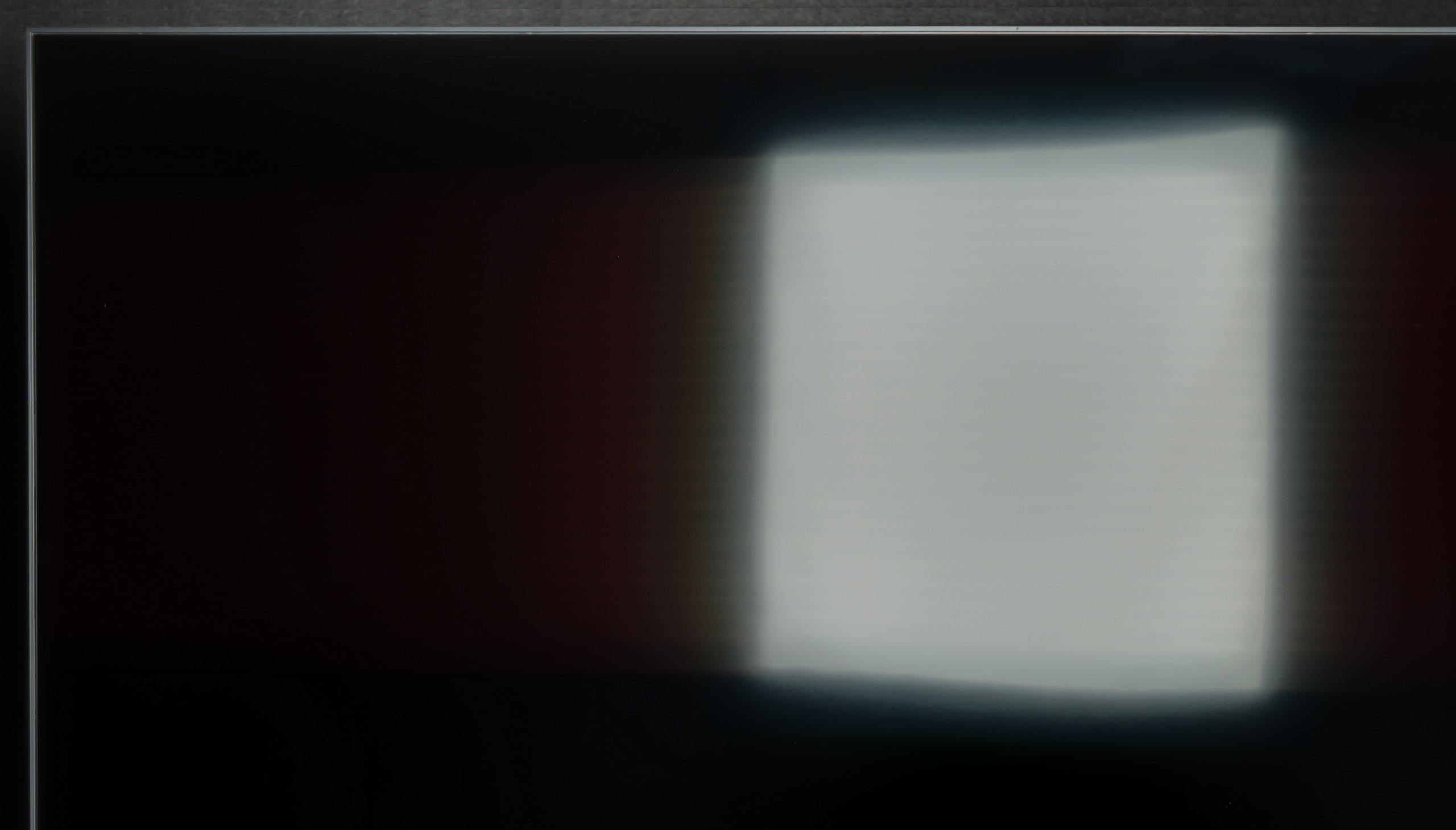
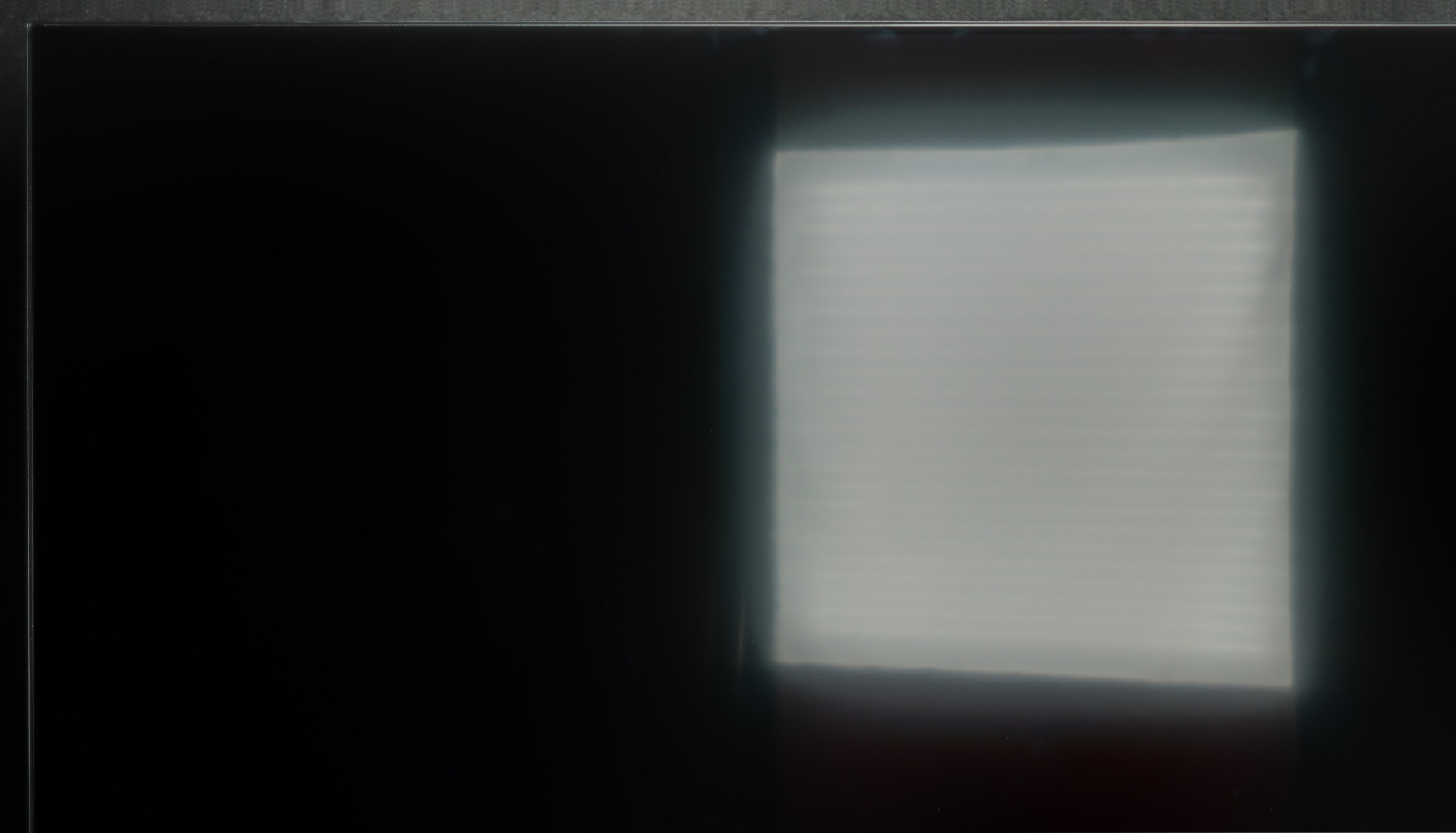
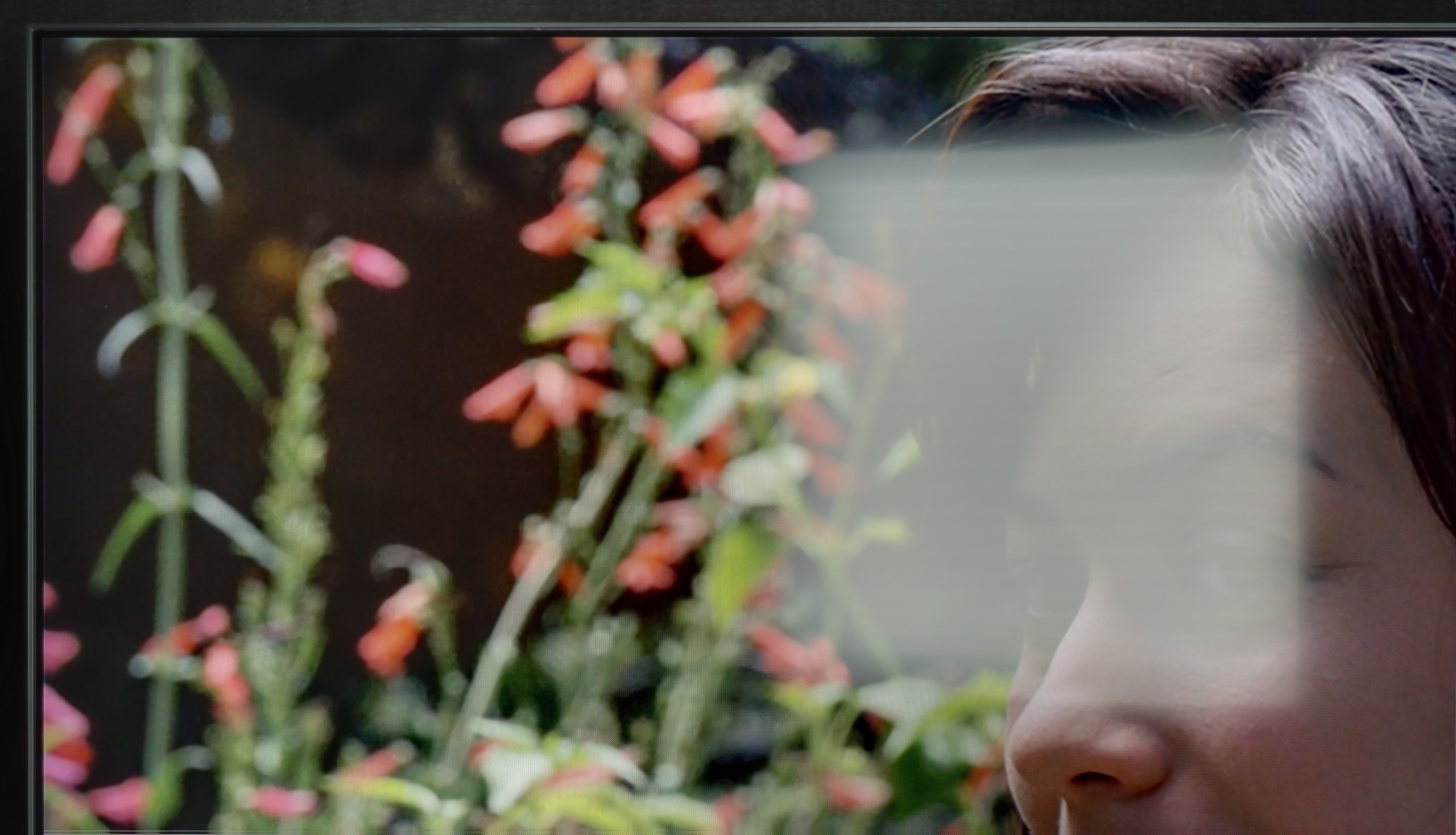
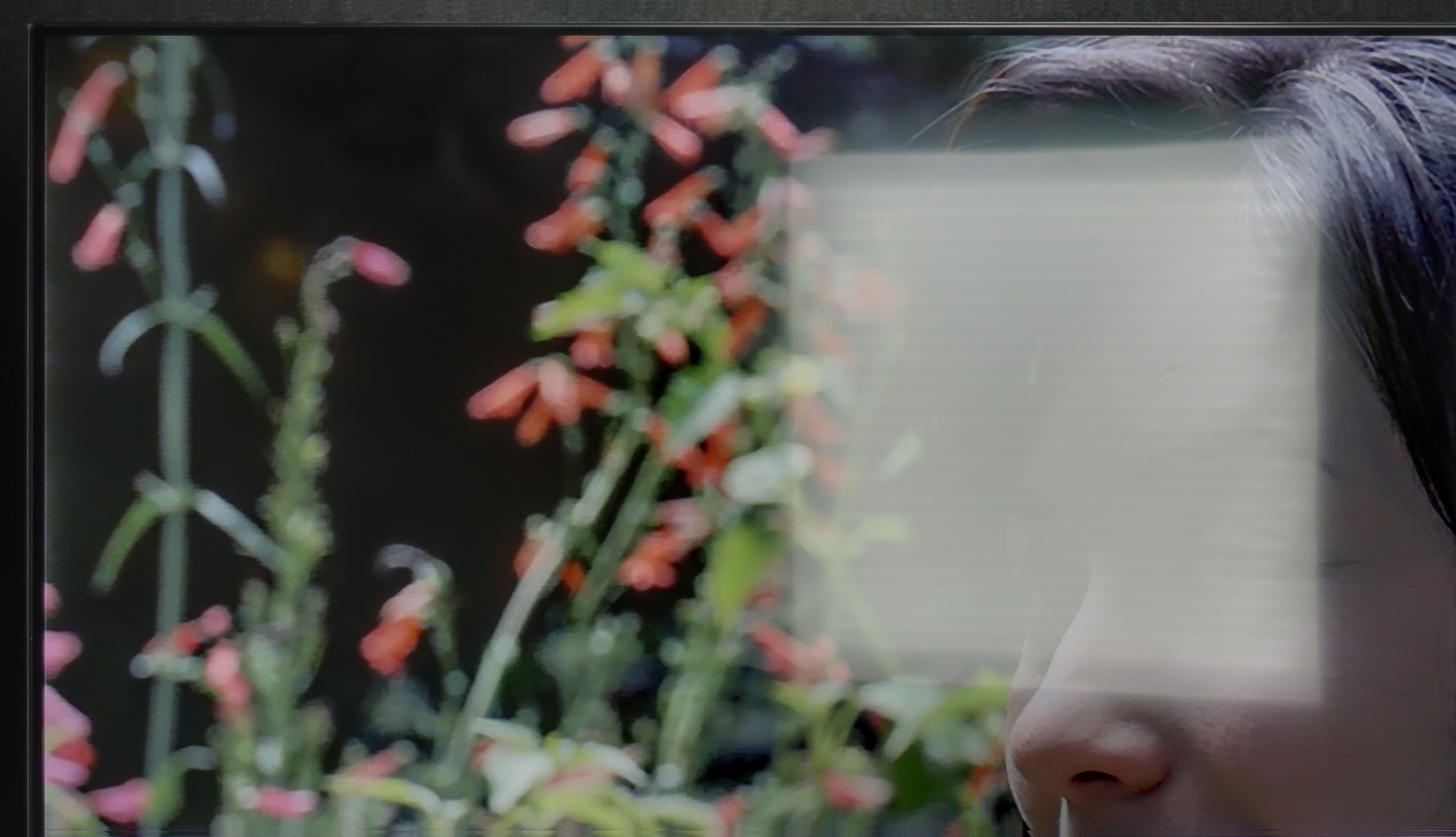
Panel brightness
Average luminance SDR
TCL V6C: 210 cd/m2
Samsung Q8F: 430 cd/m2
The Q8F performs quite well during the day. Its brightness hovers around 450 nits, which proves to be sufficient for moderately bright living rooms. It is not a television that will win the battle against sunlight streaming directly through the window, but under typical home conditions, the picture remains clear and appealing. A major plus is the satin finish on the screen, which effectively reduces light reflections and allows for color saturation to be maintained even when the room is bright. As a result, watching series during the day or evening sports broadcasts with the lights on is not a problem. The Q8F does not aspire to be a cinema television in full sunlight, but as a daily screen in normal home conditions, it performs really solidly.
The performance of the V6C during the day is not one of its strong points. It is a relatively dark television, so it simply does not cope well in brightly lit rooms. The satin coating of the panel somewhat dampens reflections and indeed limits bothersome glare, but it is not enough to speak of full viewing comfort. When a lot of natural light enters the room, the screen is unable to "break through" it, resulting in a dim and poorly readable image. The V6C is definitely a piece of equipment that feels better during evening screenings than in sunny midday.
Panel details
Subpixel Structure:
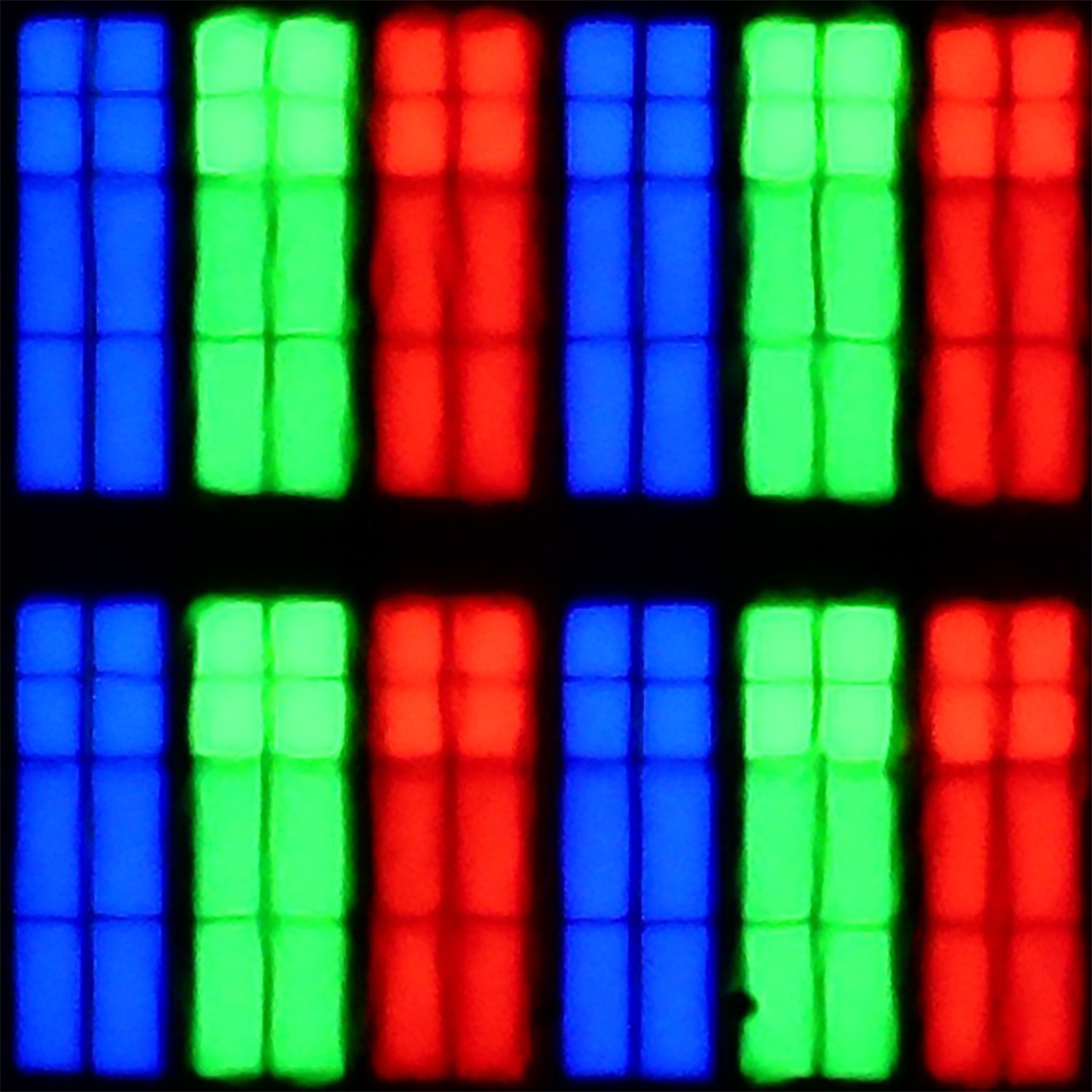
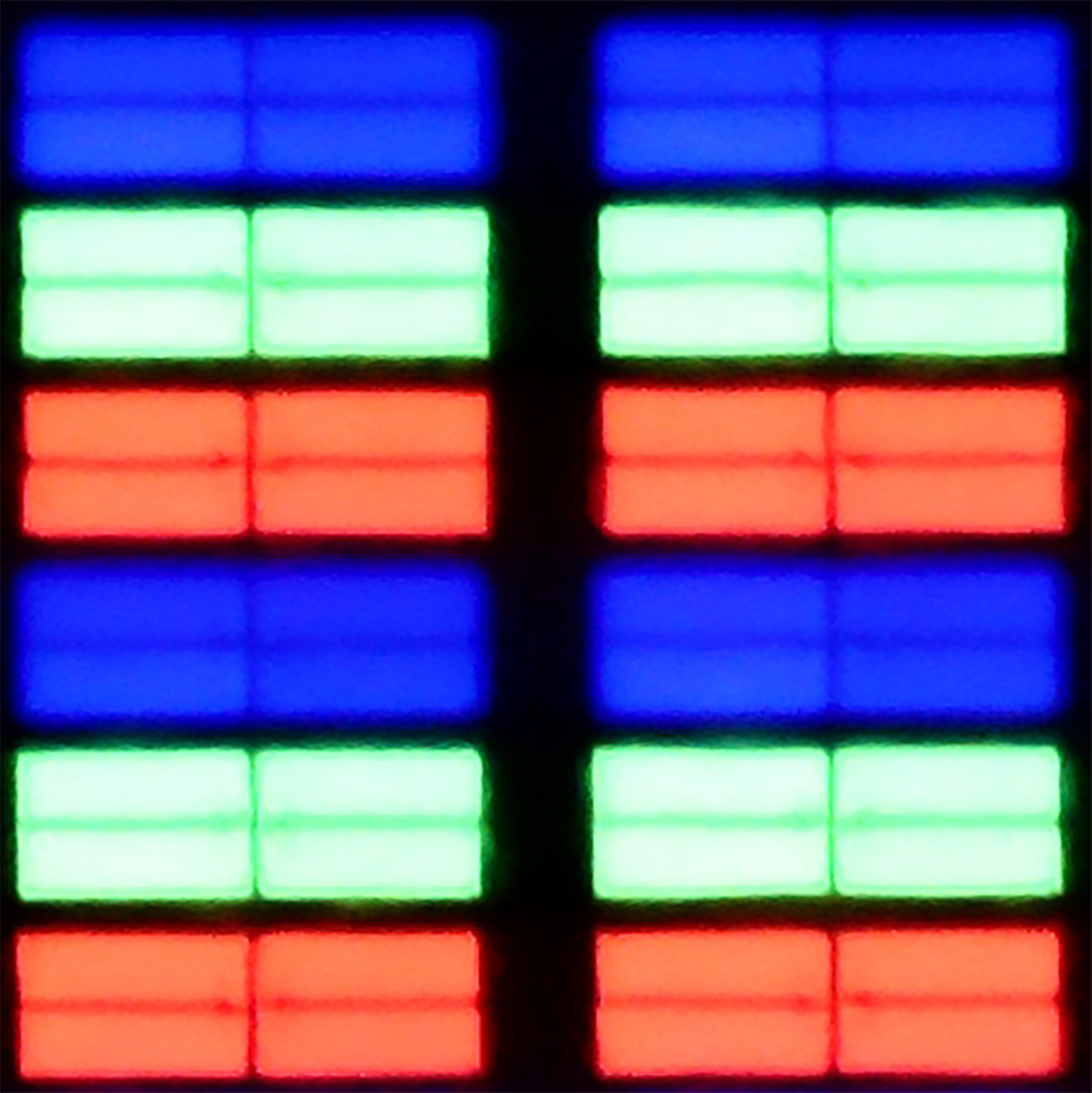
Panel uniformity and thermal imaging:
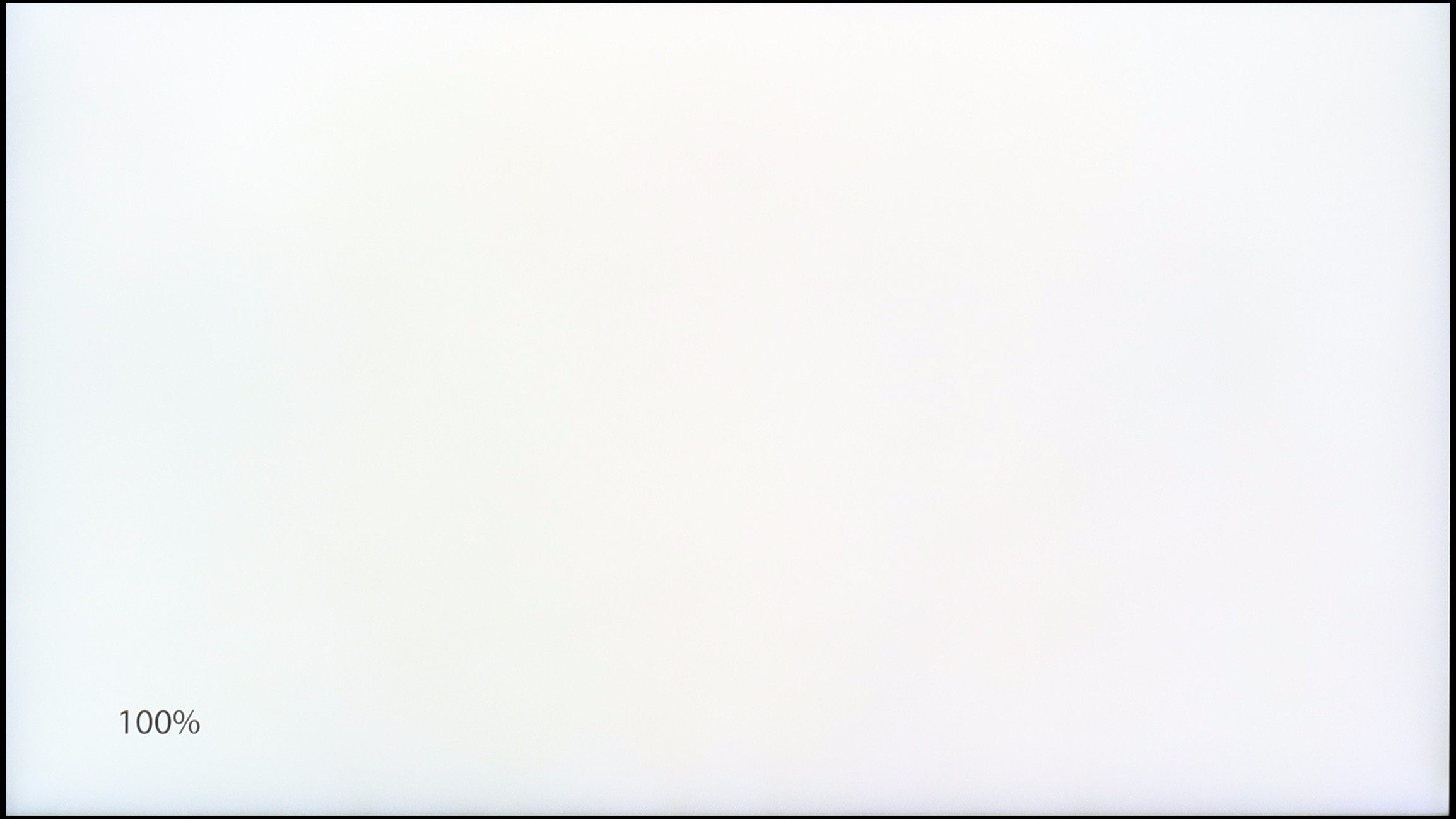
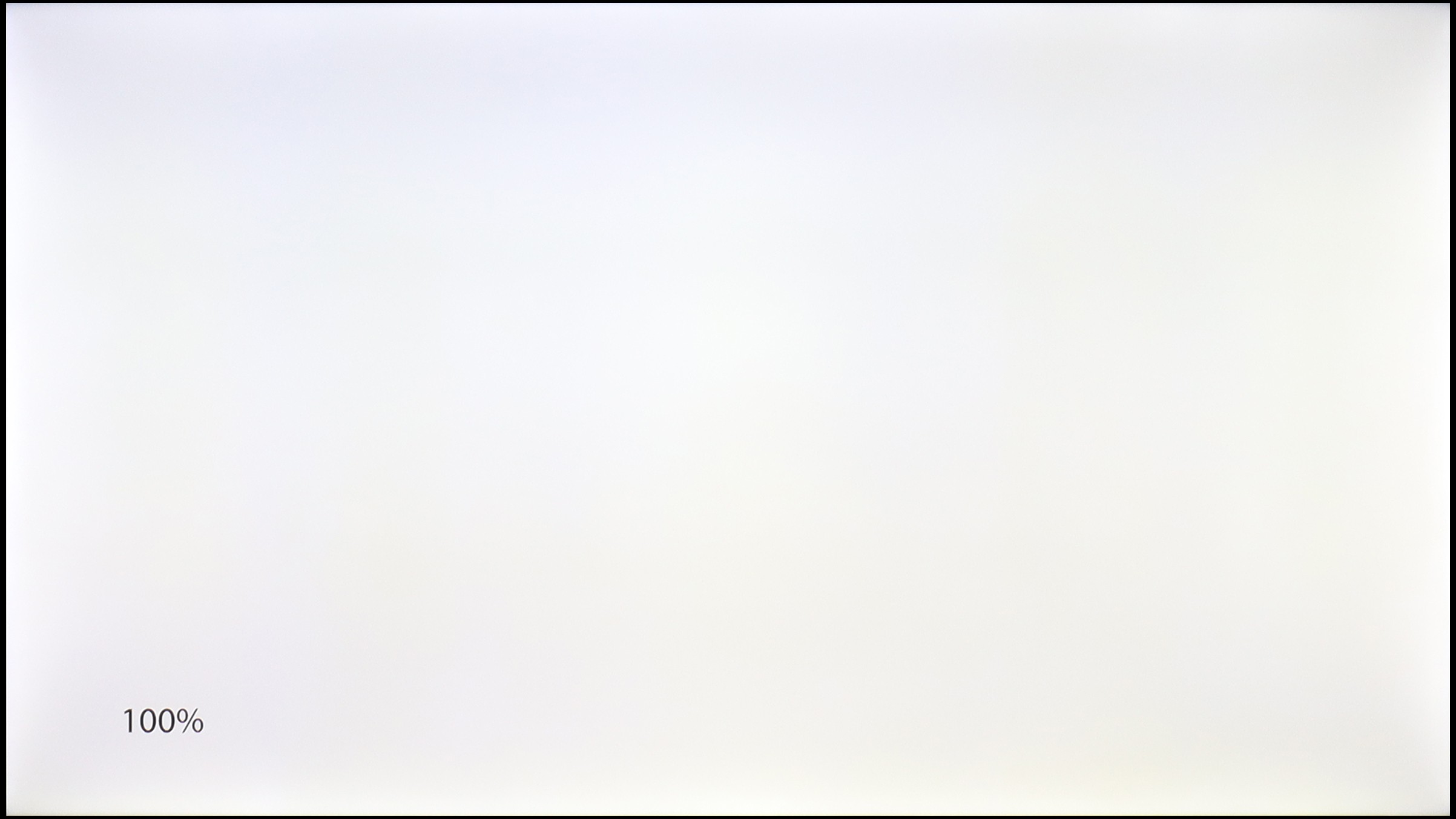
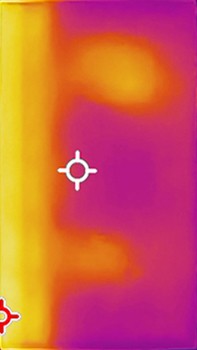
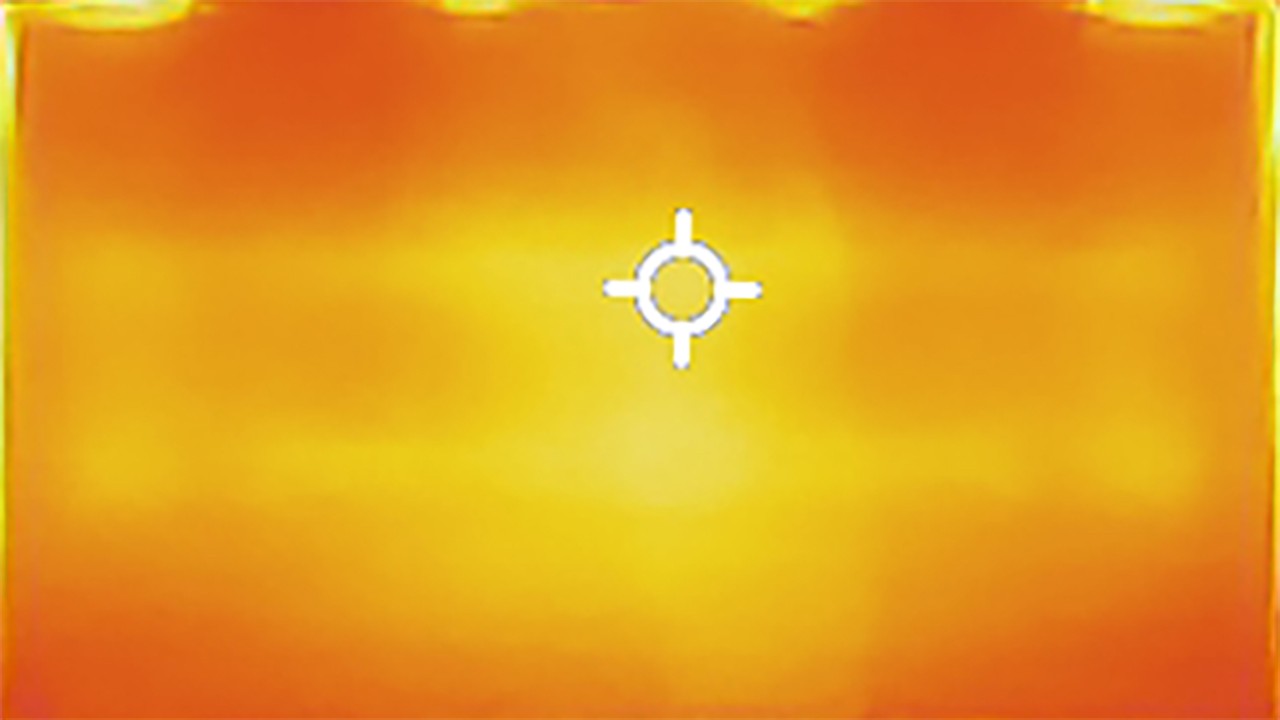
Samsung Q8F
TCL V6C
TV features
7.3/10
7.3/10
- HDMI inputs3 x HDMI 2.0, 0 x HDMI 2.13 x HDMI 2.0, 0 x HDMI 2.1
- OutputsToslink (Optical audio), eARC (HDMI), ARC (HDMI)Toslink (Optical audio), eARC (HDMI), ARC (HDMI)
- Network InterfacesWi-Fi 2.4GHz, Wi-Fi 5GHz, Ethernet (LAN) 100MbpsWi-Fi 2.4GHz, Wi-Fi 5GHz, Ethernet (LAN) 100Mbps
- TV receptionDVB-T, DVB-T2, DVB-S, DVB-S2, DVB-CDVB-T, DVB-T2, DVB-S, DVB-S2, DVB-C
Classic features:
- Recording to USB (terrestrial TV)
- Recording programming
- Picture in Picture (PiP)
- RF remote control (no need to aim at the screen)
- Backlit remote control
- Teletext
- Audio only mode
- Bluetooth headphones support
- Simultaneous Bluetooth headphones & TV audio
Smart features:
- AirPlay
- Screen mirroring (Windows Miracast)
- Voice search
- Voice search in native language
- Ability to connect a keyboard and mouse
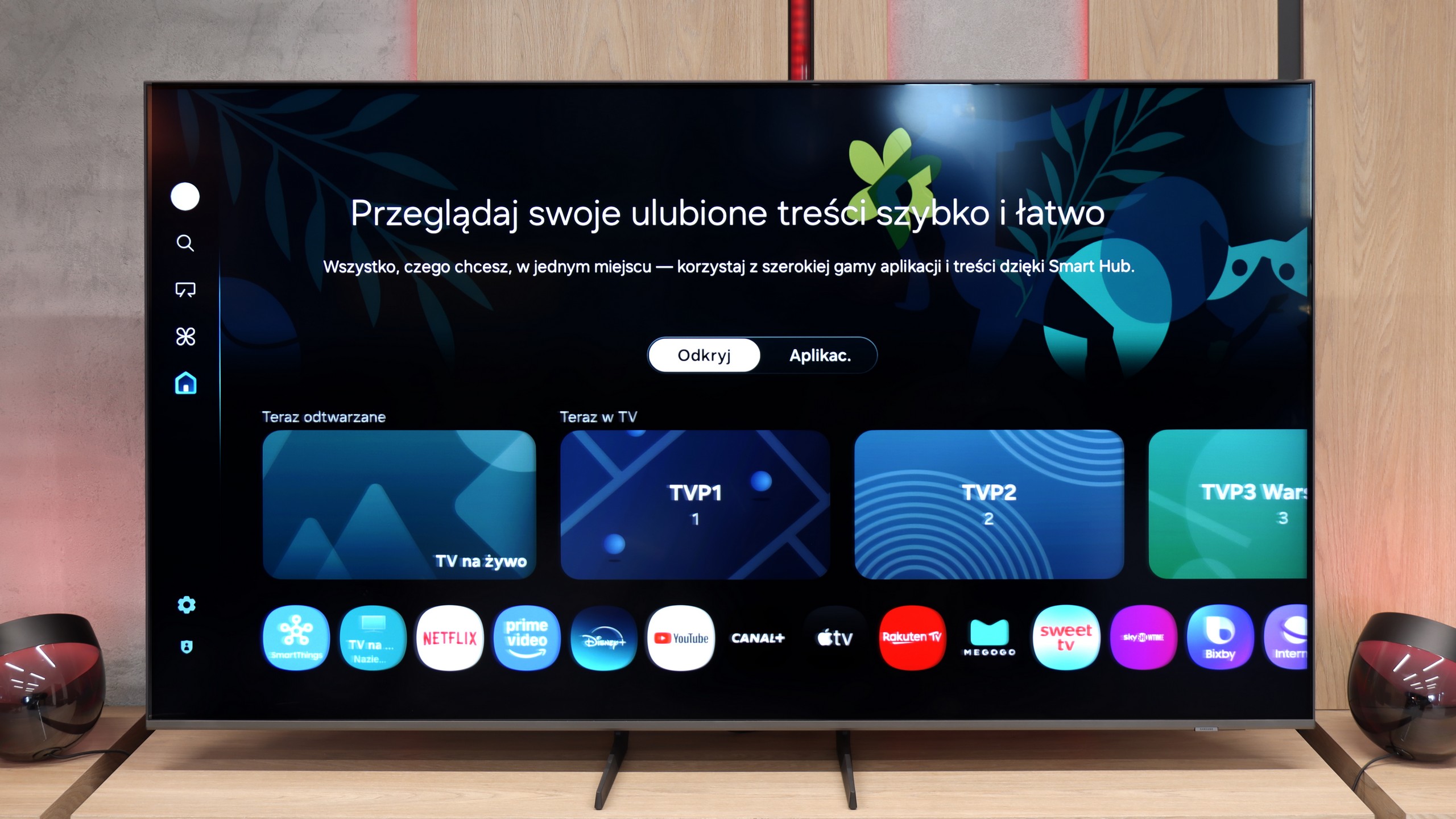
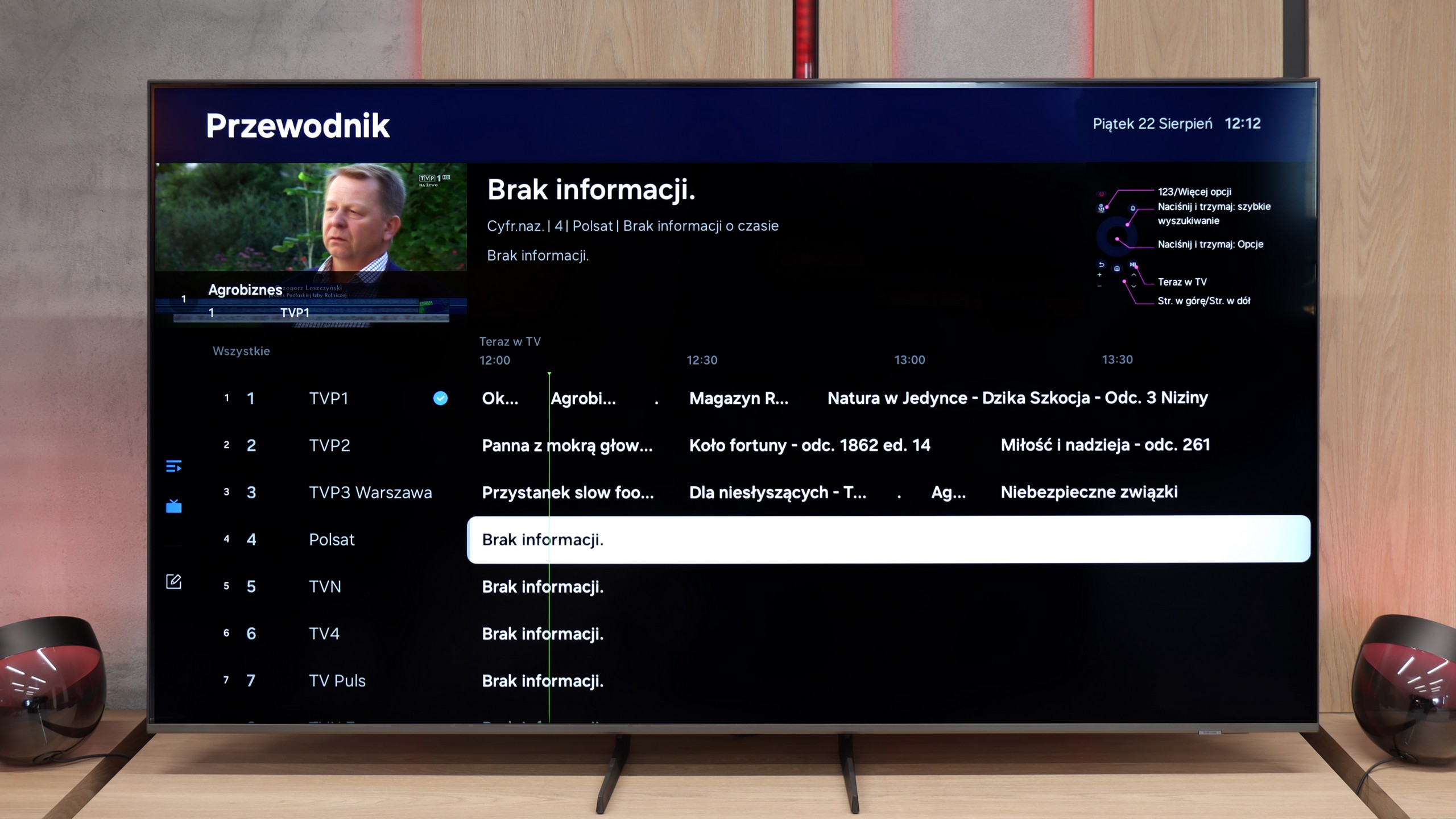
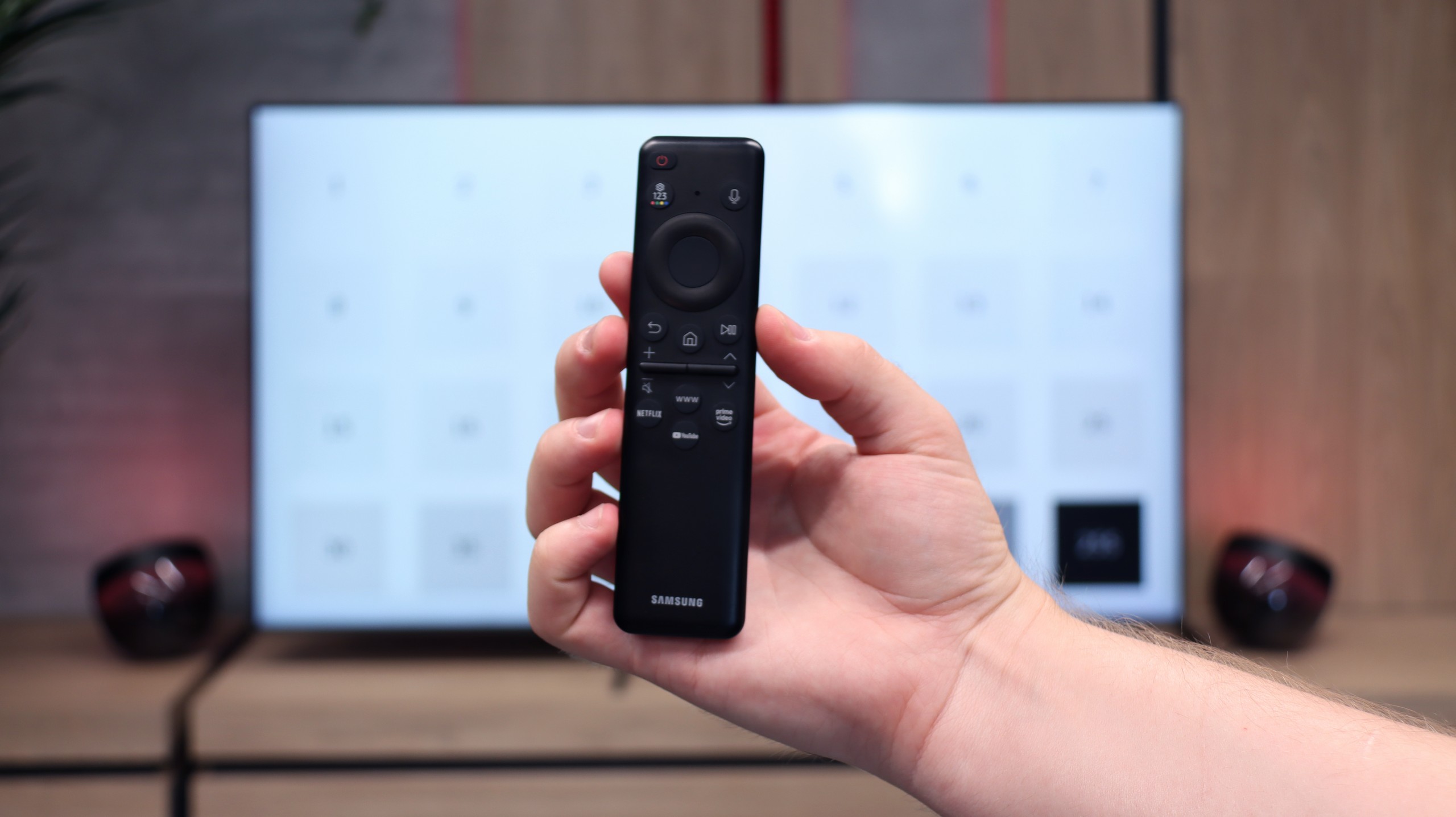
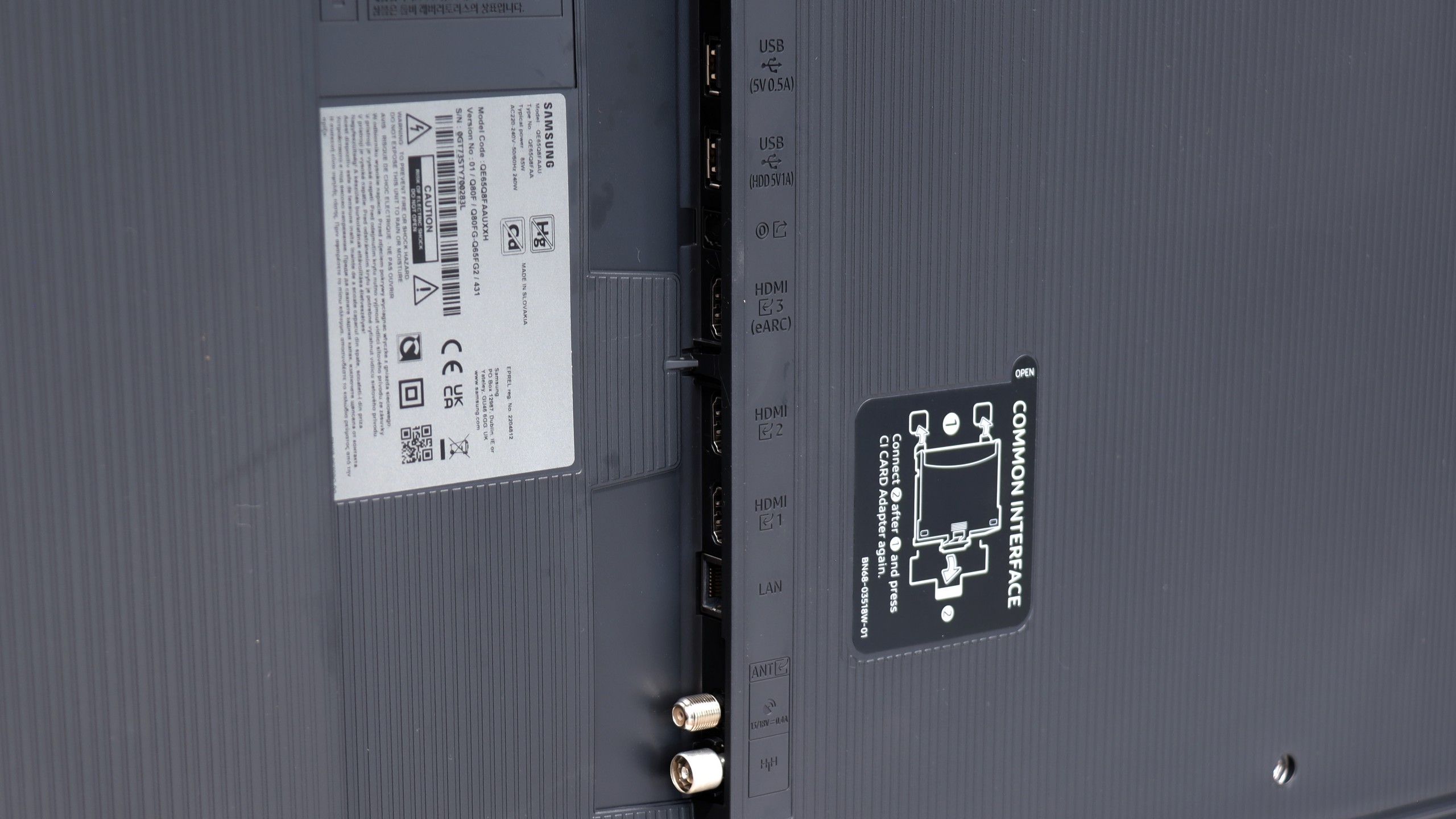
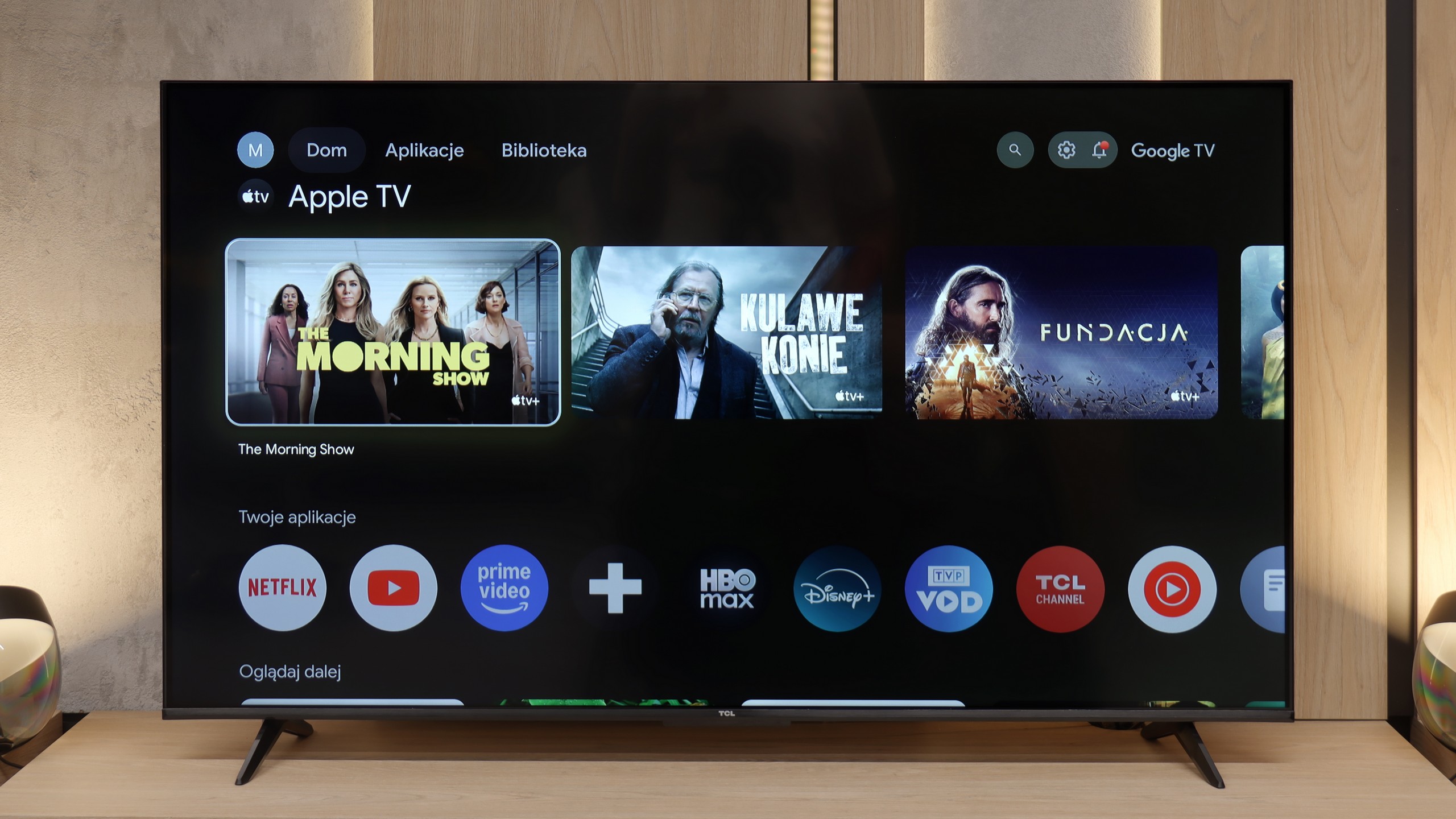
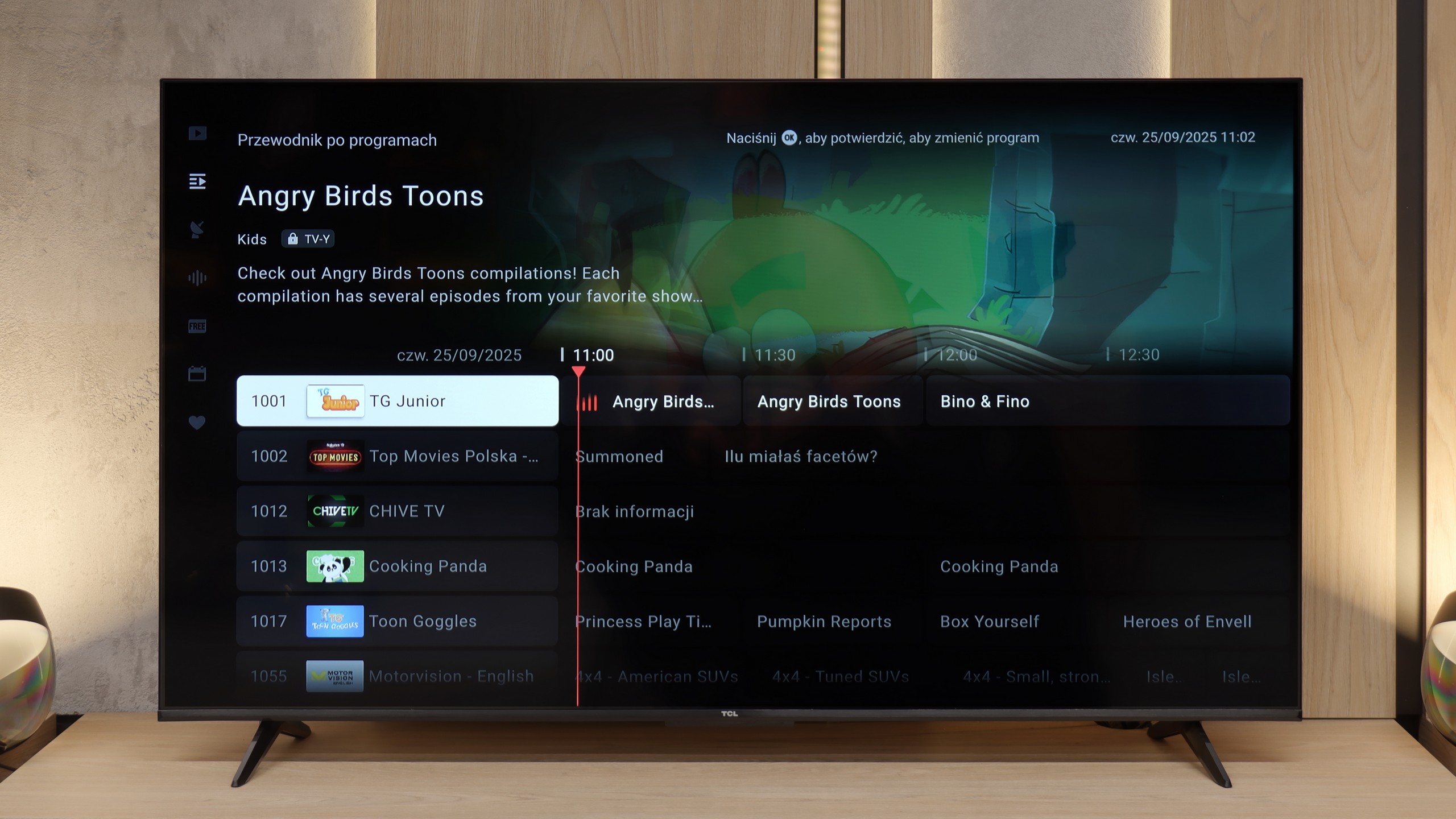
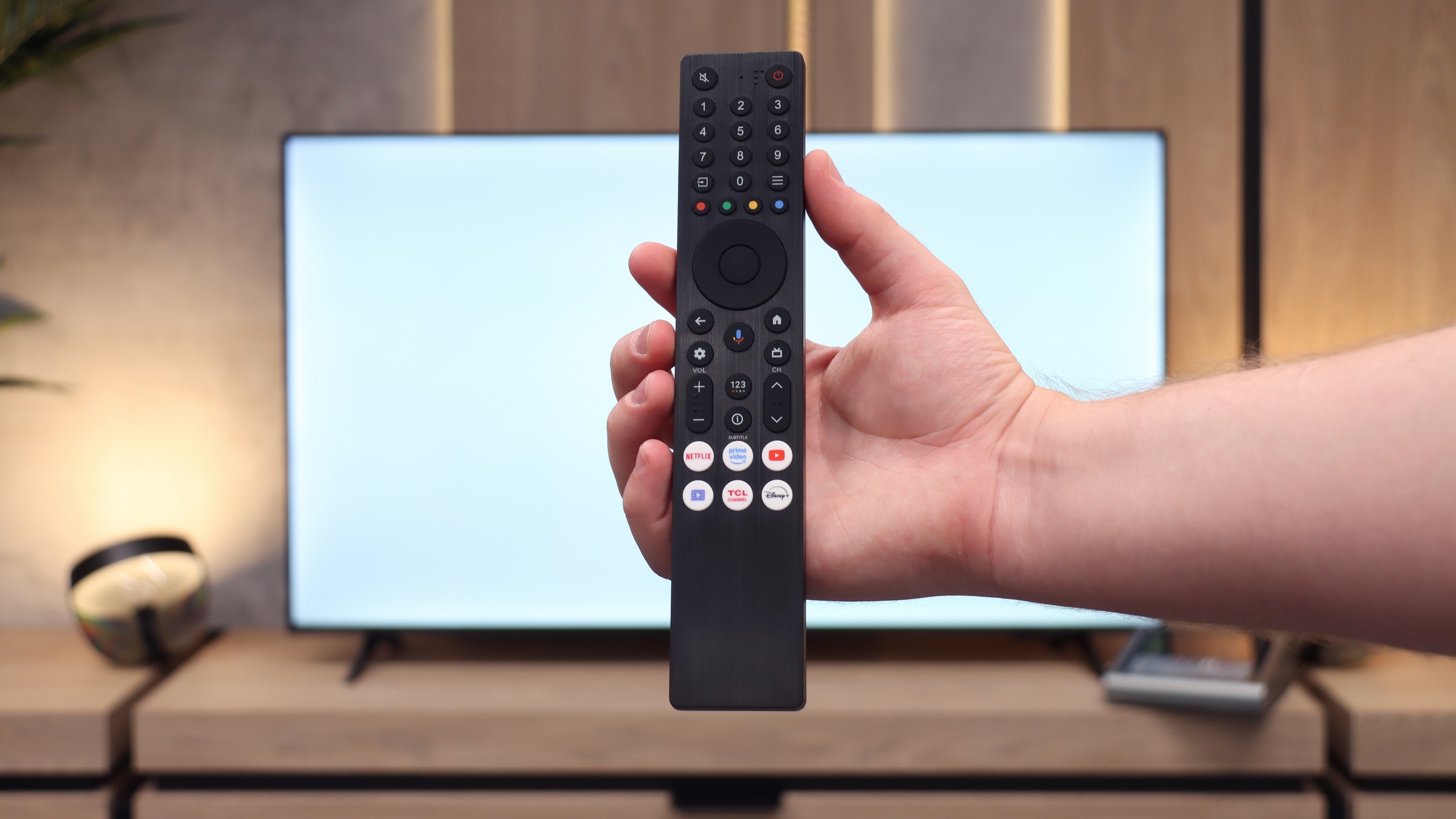
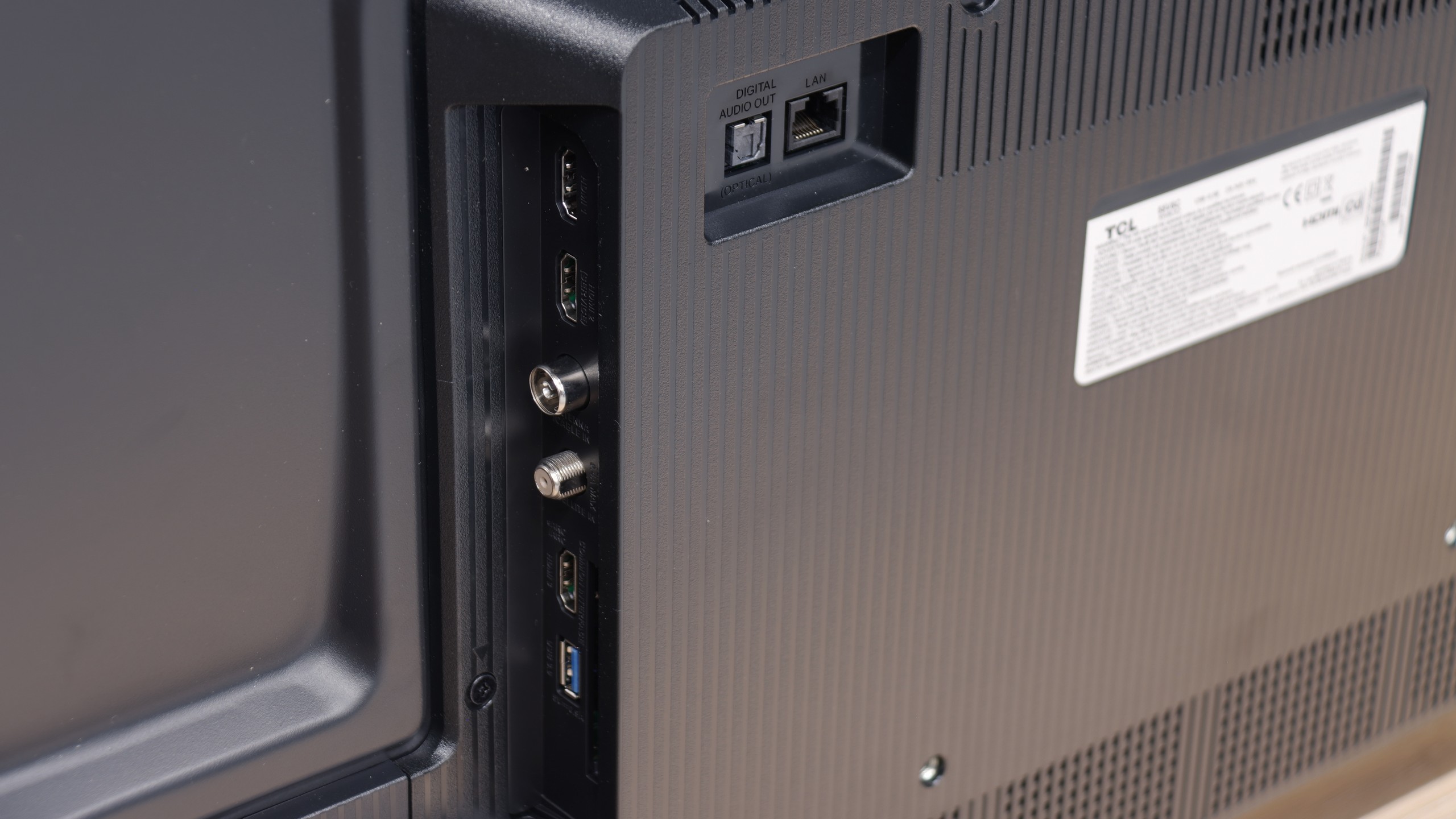
SmartTV Features: Tizen
In terms of smart features, the Q8F is on par with what Samsung has accustomed us to. On board, we have the Tizen system – fast, intuitive, and well-integrated with other devices. AirPlay, screen mirroring, and simple voice commands work without issues, so the basics are perfectly covered. Additionally, there’s SmartThings, an app that turns the TV into the center of the home ecosystem. You can connect a washing machine, vacuum cleaner, bulbs, or speakers and control everything from one place, including the TV. There’s no shortage of apps within Tizen for watching movies or series either – Netflix, YouTube, Disney+, and Prime Video are readily available. However, it’s worth remembering that Tizen is a closed system, so anyone hoping to install less popular programs may be disappointed.
Classic Television
Classic television fares worse. The Q8F simply serves as a screen here – it will display the image, but we won’t find additional features like USB recording or PiP mode. The remote is small and minimalist. It looks modern, can be charged via solar batteries on the back cover, or through USB-C, but it's important to note that it may not appeal to everyone – especially older users may miss traditional buttons. However, it must be honestly admitted that Samsung has consistently directed its TVs (as well as competitors, who have copied some ideas from them) towards smart home integration, rather than equipment "for grandma and grandpa." Given the immense popularity of the brand, it can be assumed that most users, even older ones, have already grown accustomed to the fact that the era of remotes with a whole range of rubber buttons is slowly coming to an end.
SmartTV: GoogleTV
The biggest advantage of the V6C is the Google TV operating system. It is an extensive platform that provides access to a vast database of applications – from YouTube, Netflix, Disney+, and HBO Max to less popular programs that can be easily downloaded from the Google store. In addition, it features useful functions such as AirPlay, screen mirroring, and voice search. However, it’s important to remember that Google TV is not one of the lightest systems. In the case of the V6C, which is a budget TV, you can sometimes notice stuttering and slower interface responses. This doesn’t ruin everyday use, but it can be noticeable, especially compared to more expensive models from TCL or competitors.
Classic Features
The V6C also caters to those who use television in a traditional way. The package includes a classic remote control with a large number of buttons, including a full numeric keypad. This is practical for people watching terrestrial or cable television. The TV also offers teletext and a clear interface for channel navigation. The seamless Bluetooth connectivity is a plus – pairing headphones or a speaker is hassle-free. Therefore, the V6C performs solidly as a daily television, although it’s important to keep in mind certain shortcomings. We won’t find USB recording or picture-in-picture (PiP) mode here, which are functions that may mainly be needed by older users. (Though not only 😉).
Playing files from USB
9.1/10
8.7/10
Supported photo formats:
Maximum photo resolution:
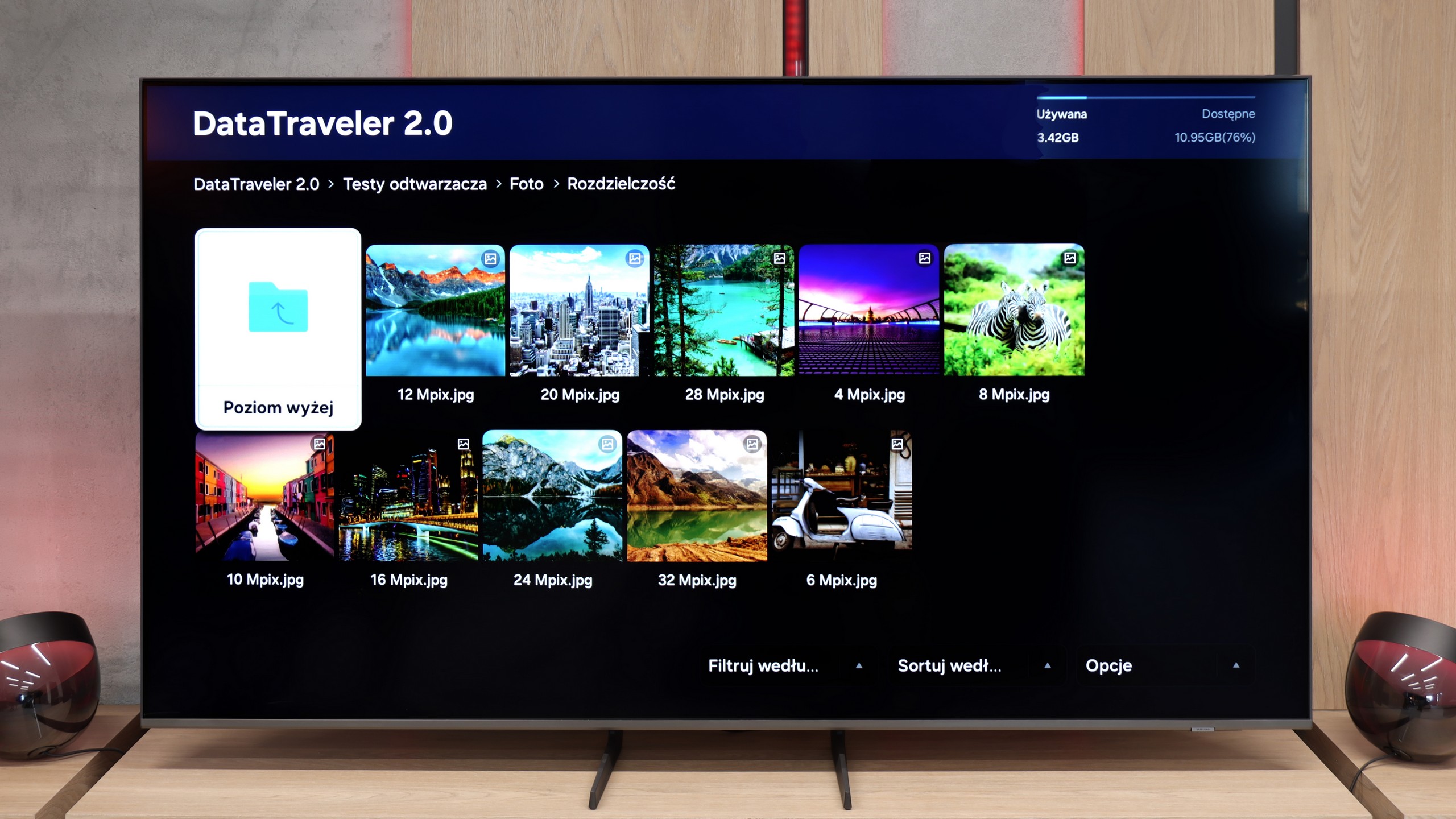
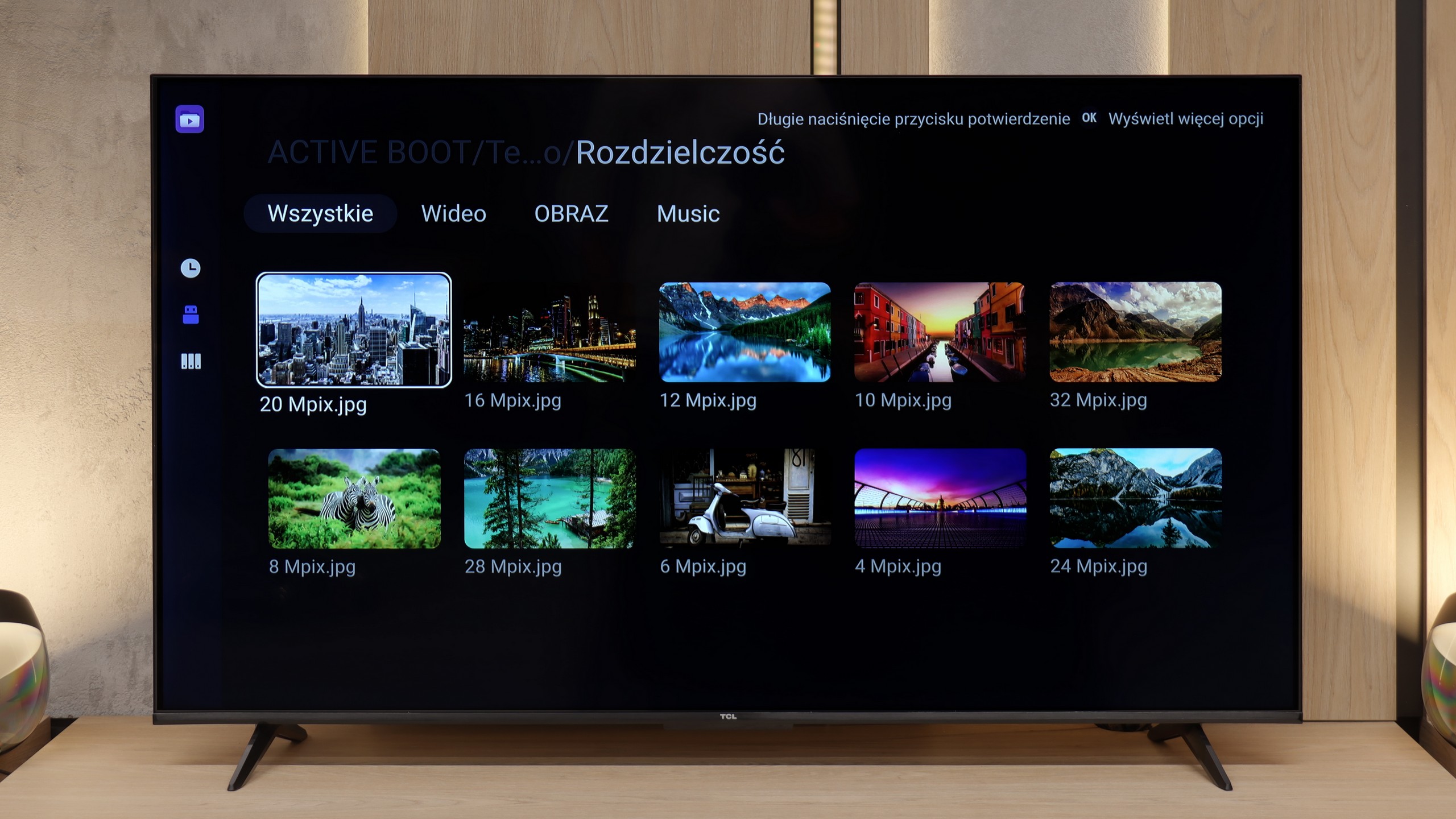
Samsung Q8F handles playback of files from USB quite efficiently. It supports almost all popular video formats and photos, so you can easily upload a holiday movie or a family album. There are occasional exceptions for less popular photo formats, but the most important JPEG works perfectly, which will be crucial for most users. It's just a shame that Tizen does not allow for the installation of alternative players like VLC. Then even less popular formats would not pose any problem.
Playing files from USB on the V6C is quite decent. The built-in player handles most popular video and audio formats, and during testing, we did not encounter major difficulties launching typical files. The biggest problem arose with very high-resolution photos – above 20 Mpix, the television often refused to cooperate. We also noticed minor shortcomings in functionality regarding video playback. The video player does not allow changing the font colors, which had previously worked without issues in other TCL models. Fortunately, these are inconveniences that are easy to work around. Thanks to Google TV, you can install external applications such as VLC or KODI, which solve most of the problems and offer significantly broader file handling capabilities.
Apps
8.7/10
9.6/10














































Sound
6/10
5.8/10
- Maximum volume84dB83dB
- Dolby Digital Plus 7.1
- Dolby True HD 7.1
- Dolby Atmos in Dolby Digital Plus (JOC)
- Dolby Atmos in Dolby True HD
- DTS:X in DTS-HD MA
- DTS-HD Master Audio
The sound on the Q8F can be described as acceptable. You can hear a slightly defined bass, but it is really minimal – the slim design of the TV simply doesn't allow the pair of 2 × 10 W speakers to spread their wings. This is a typical scenario for most TVs: if someone cares about truly cinematic experiences, it's worth considering a soundbar. Samsung has a really wide range in this category across various budgets, so it's easy to find something suitable. The TV itself will work for watching traditional television and series from time to time, but you shouldn't expect much more in terms of sound excitement.
The sound in the V6C does not stand out in any particular way compared to competitors in the same budget. The audio is quite flat, and there is simply a lack of bass. Fortunately, the TV can play loud – a measured 83 decibels is quite a decent result, and importantly, even at maximum volume, there is no unpleasant cracking that often bothers cheaper models. However, it's worth noting that it's not just the quality of the built-in audio that is beneficial, but the support for advanced surround sound formats. The V6C handles Dolby Atmos and DTS:X, so connecting a soundbar or another external audio system will not pose a problem and will allow for full utilization of these codecs. This is good news for those who plan to expand their setup with additional sound systems.
Acoustic Measurements
84dBC (Max)
75dBC
83dBC (Max)
75dBC
